
It’s rare to explore a truly under-the-radar destination. Even so, one notable region in North America has quietly been building a singletrack mecca filled with some of the gnarliest trails on the continent. While the mountain biking in Quebec City is no secret to the legions of local riders, for some reason, Quebec’s incredible trails get very little press outside the province, other than the one week a year when the pros are racing at Mont-Sainte-Anne.
After sampling the superb riding for myself, the only place that I can compare the caliber of the trail building and the gnarliness of the features to is British Columbia, thousands of miles away. Quebec City is home to one of the best flow trails I’ve ridden anywhere in the world, as well as one of the gnarliest trail networks, filled with steep rock slab rolls, brutal rock gardens, slick root webs, and skinny wooden bridges. The region even boasts the most popular fat bike destination in the world and some of the most technical downhill racetracks on the planet. The diversity is unbelievable, and the quality is astonishingly high.
- Hit all five, or just choose one
- Mont-Sainte-Anne: The downhill mecca
- Vallée Bras du Nord: Epic backcountry singletrack
- Sentiers du Moulin: Technical rock slabs galore
- Empire 47: Trails for beginners to experts, close to the city
- Le Massif de Charlevoix: Lift-served enduro trails with epic views
- A trip to Quebec City is about more than just riding
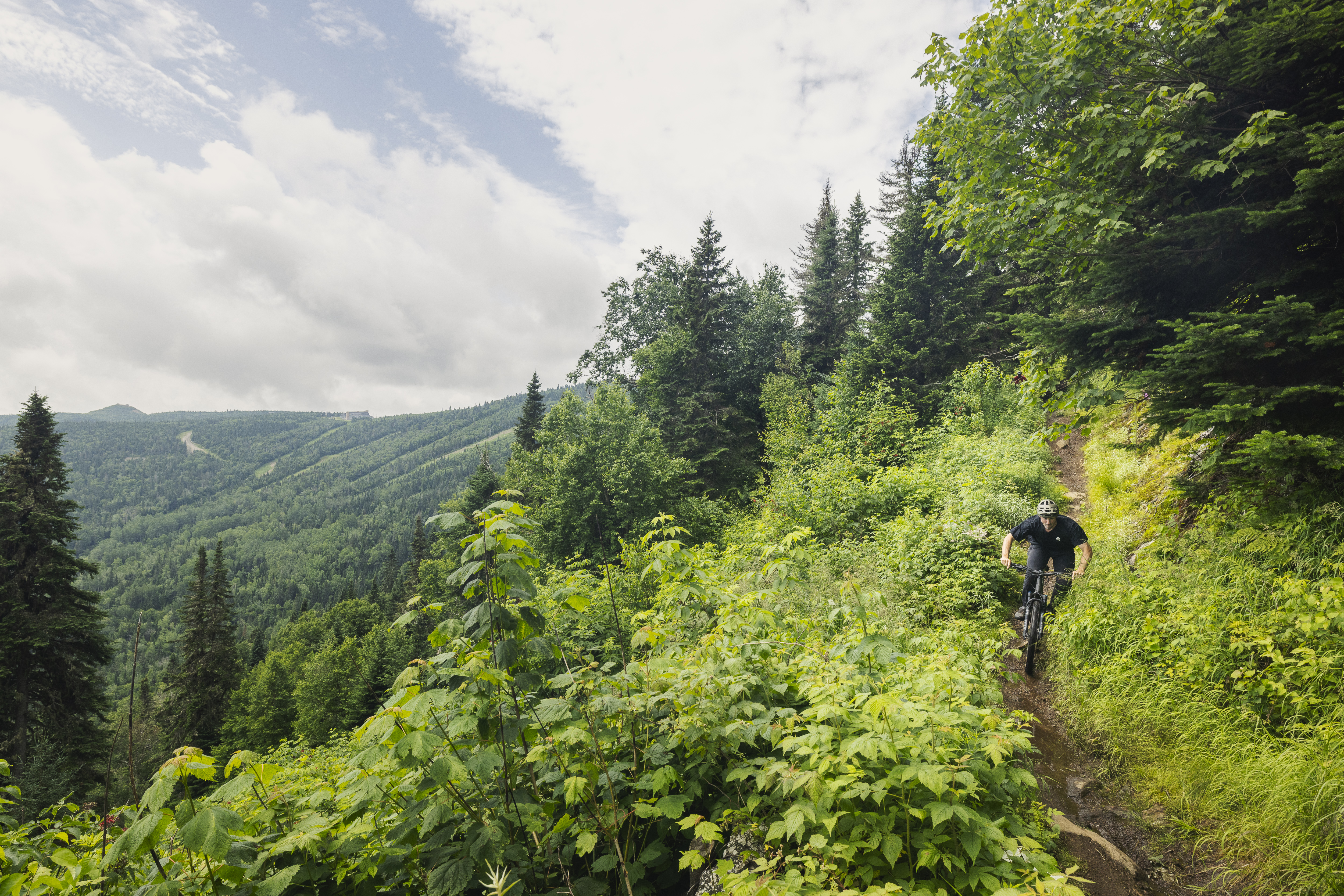
Hit all five, or just choose one
When (not if) you choose to travel to Quebec to check out their incredible network of top-tier singletrack, you could either conduct a grand tour of all five major trail systems like I did, or choose one or two trail systems to hone in on.
Below, I’ve profiled each of the five major mountain bike networks. Each has a distinct flavor and caters to a different type of rider, and each one could easily occupy an entire 3-day weekend on its own (if not longer.) Consequently, I’ve outlined lodging and dining options conveniently located near each of these respective trail systems.
That said, you could opt to base out of downtown Quebec City for the entire trip. The closest trail networks are just 20 minutes from downtown, and the furthest are only an hour’s drive away.
Peruse the menu of options below, and craft your own Québécois adventure as you see fit!
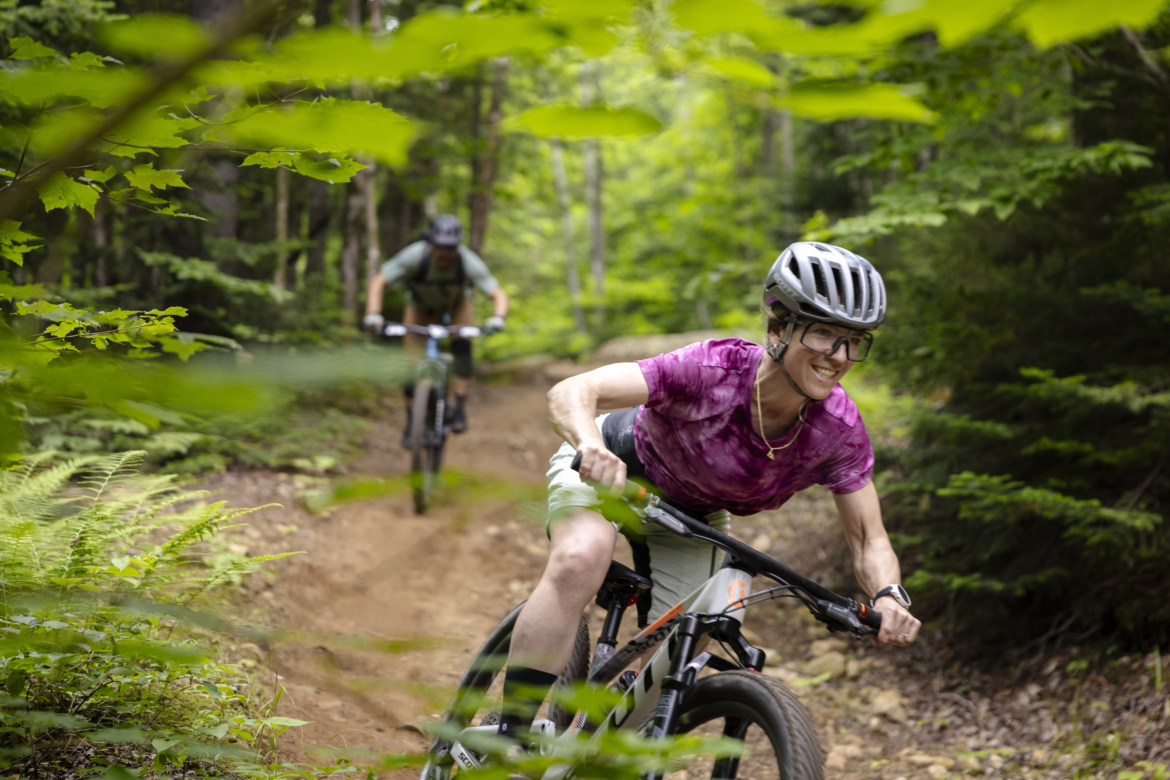
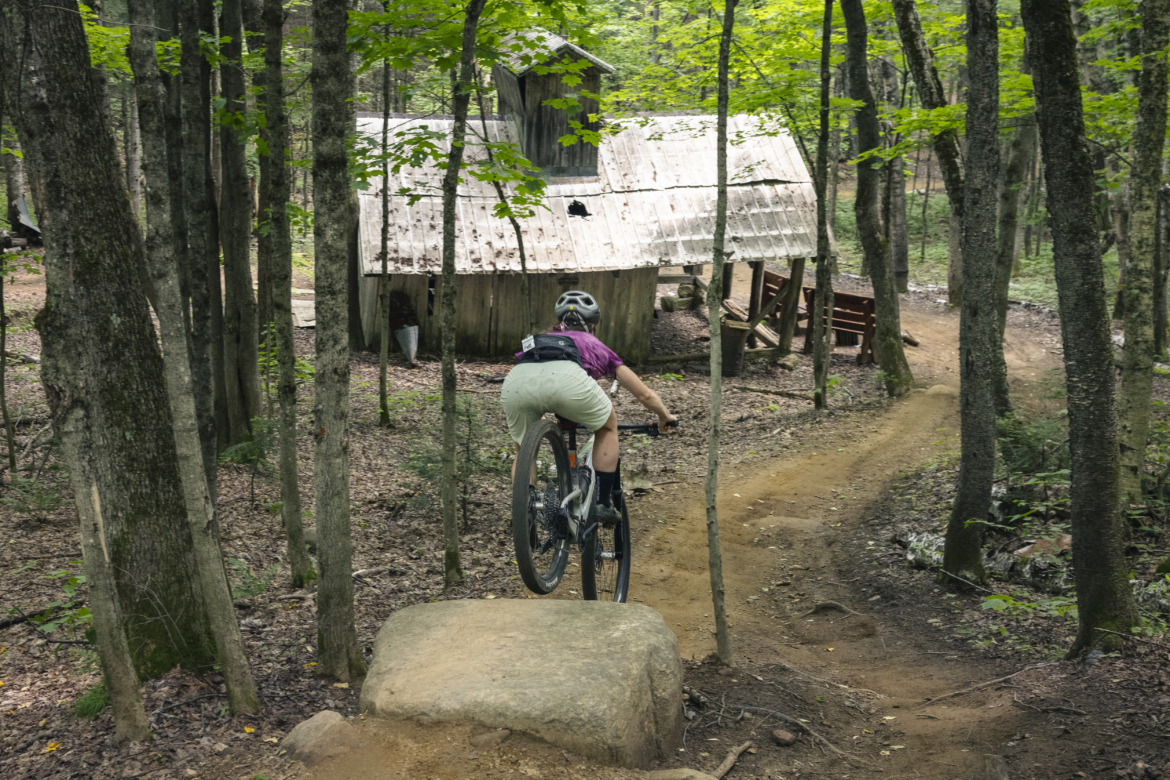
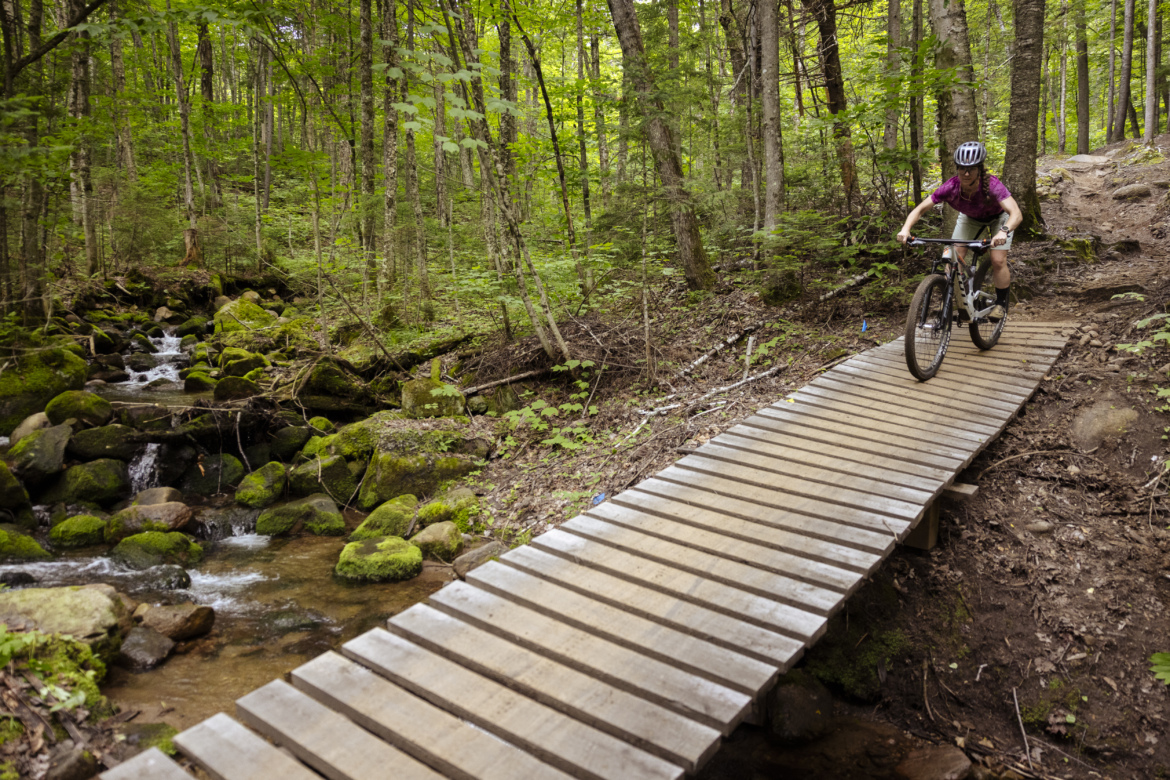
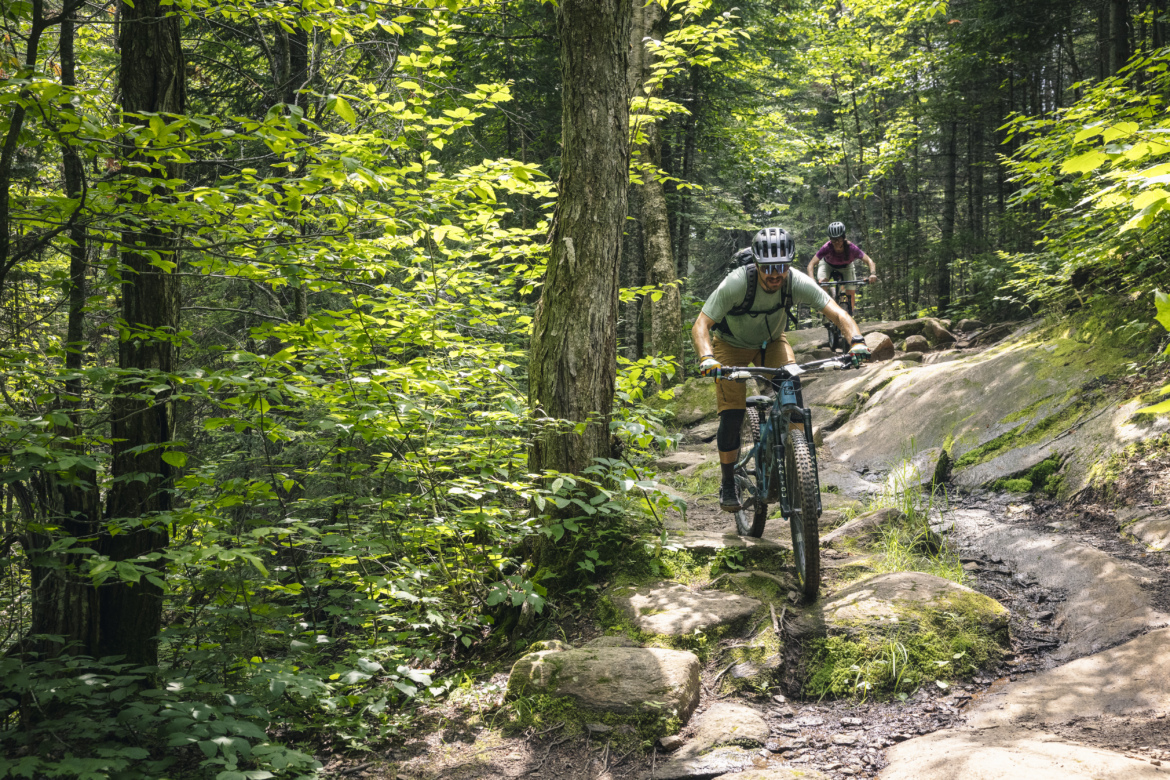
Mont-Sainte-Anne: The downhill mecca
“Mountain biking in Quebec was born here in Mont-Sainte-Anne,” said local elite XC racer Anne-Marie Gauthier. The first trails built on Mont-Sainte-Anne (MSA) were constructed decades ago by the godfather of Quebec mountain biking, Patrice Drouin. Drouin is also in many ways the godfather of World Cup downhill racing. He not only brought the DH World Cup to MSA, but in the early years of international mountain bike racing competition, he helped write some of the rules for downhill competition that are still used to this day.
In October 2025, MSA will host its 30th anniversary World Cup DH race. The race drew between 55,000 and 60,000 people the last two years, and for the 30th anniversary, it’s expected to be wilder and crazier than ever before.
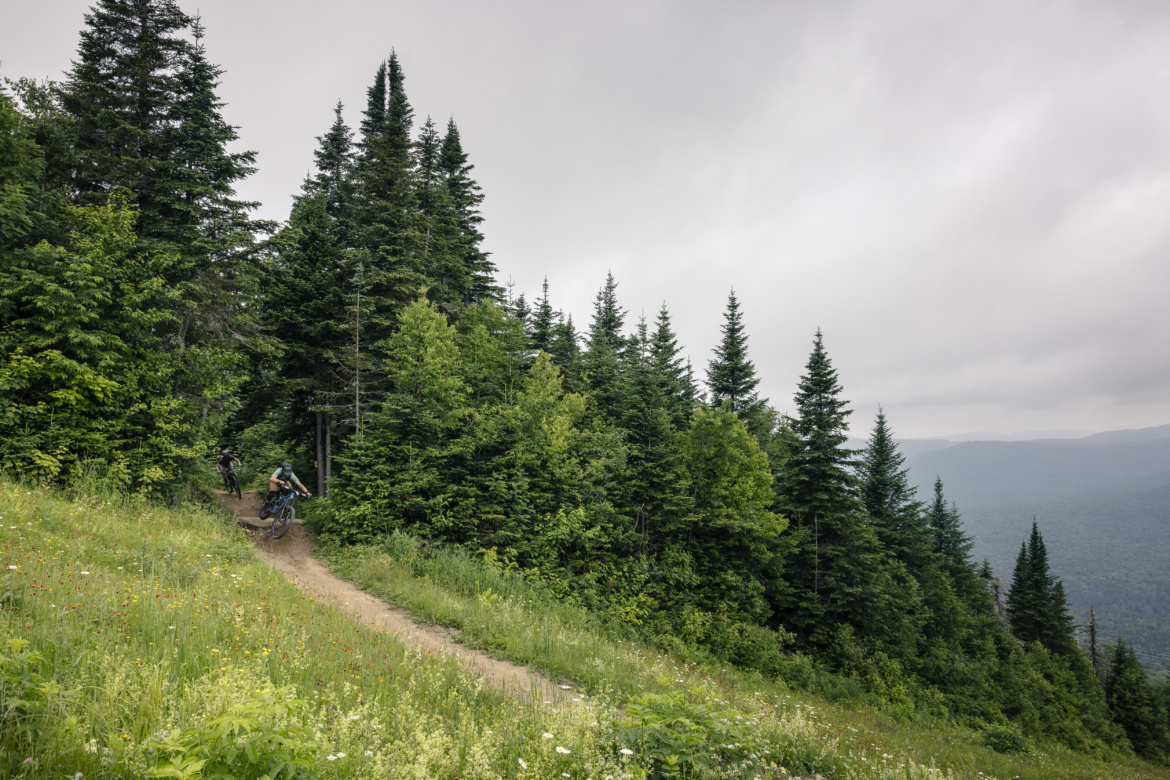
The MSA bike park is the go-to destination for die-hard gravity riders in Quebec City. Unlike some bike parks, which might have one token tech trail, the bike park at MSA is veritably filled with pro-level DH race tracks. While for many years, the World Cup track itself was only opened for the event, today, any rider can show up and train on one of the gnarliest DH race tracks in the world.
In addition to double black diamond lines, riders will also find a small mix of trails with easier difficulty ratings, ranging all the way down to green. But be forewarned: even the blue and green trails feature plenty of rocks and roots. There aren’t any true “flow trails” at MSA, despite what the locals might label as such. Even if you’re riding a trail that is more flow-oriented, you’ll still need to be prepared for plenty of rock gardens, small slabs, and root webs.
But what many riders don’t know is that MSA is home to so much more than just gnarly downhill tracks. In fact, the entire trail system boasts 165km (102mi) of mountain bike trails. While the network is connected to the bike park, the bulk of the trails are XC and enduro-oriented, with plenty of climbs and descents on narrow hand-built singletrack.
Riders can even use the gondola to create enduro-style laps that mix MSA’s 625m (2,050ft) of free vertical with pedal-driven climbs deep in the mountains. And, of course, if you want to go for an entirely pedal-driven ride, there are plenty of options in the expansive network. In fact, MSA also hosts World Cup XC racing in addition to DH, meaning the cross-country trails are similarly world-class.
During my time riding at MSA, I had no desire to test my mettle on the double black (or harder) lines, but I still enjoyed single black descents in the bike park, like La Vietnam, and the blue La Bapteme. When we left the bike park for a longer lap with a few pedal-driven climbs, we followed L’échappée to reach L’Adorila — the best flow trail-style descent we experienced on the mountain with great berms, jumps, and a few rock drops.
A full-day ticket with unlimited lift rides costs $64 CAD. If you want to pedal an enduro-style itinerary, you can purchase a single lift ride for $52, and have unlimited access to the XC trails. Finally, you can purchase an XC-only pass for $33.
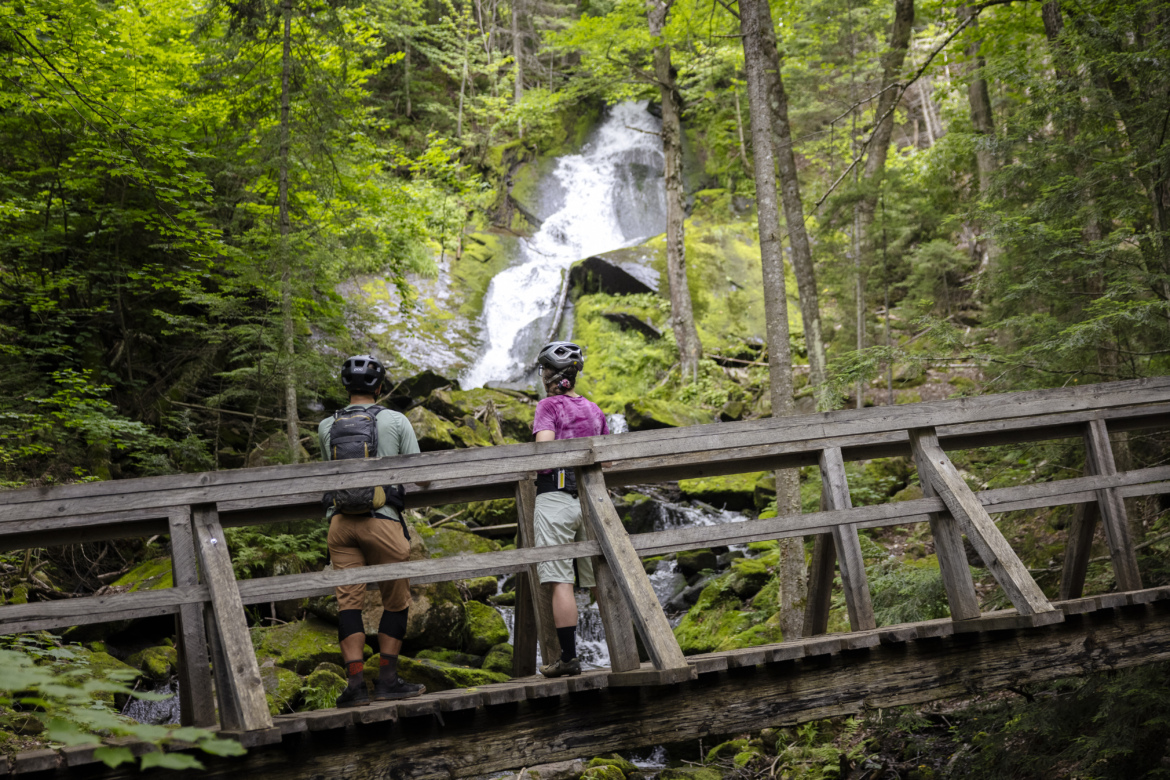
Off the bike in Mont-Sainte-Anne
Along with VBN, MSA is one of two trail systems with a campground directly connected to the trails. The campground is located on the northern end of the trail system, embedded in the XC trails, while the gondola is located on the southern end of the network. A plethora of trails connect the two, including a crushed gravel path and a direct singletrack connection known as La Bouttaboutte.
La Bouttaboutte is a critical singletrack conduit through the trail system, and many routes end up on this trail at some point. Despite being a connector, it’s still an entertaining ride filled with plenty of roots and rocks to keep you on your toes.
If camping isn’t your jam, there are plenty of lodging options to choose from near MSA. But for those who want a taste of mountain biking lore, you can’t beat a stay at Patrice Drouin’s personal Bed and Breakfast, Auberge et Campagne, just a few miles up the road. Drouin and his partner, Lisa Linton, run the small B&B themselves. The place is filled with World Cup DH lore, including historic posters and images that are rare collector’s items.
Well, at least you should try to stay at Patrice’s place (as it’s locally known). It’s fully booked almost every weekend, and forget trying to stay there during the World Cup. The B&B fills up with some of the top downhill racers in the world, who all want to spend some time shooting the shit with Patrice.
Food options off the mountain are a bit limited, although the Brasseur des Monts (a microbrewery with MTB vibes) is passable. On the weekends, you can get a drink at Chez Pat, Patrice’s own bar connected to the B&B.
As you can imagine, MSA offers every bike-oriented amenity that you’d expect from a top-tier bike park, including rental bikes and a shop. There are also lodging and dining options on-site, if you want to ride directly from your room to the gondola.
Finally, for a quick hiking adventure, don’t miss the walk down the nearly 400 steps to see the three-tiered waterfall Chute Jean Larose. It’s conveniently located just across the street from MSA.
Vallée Bras du Nord: Epic backcountry singletrack
While Mont-Sainte-Anne may have been the birthplace of mountain biking in Quebec, the development of mountain bike trails at Vallée Bras du Nord (VBN) kick-started a mountain bike trail building boom in the Quebec City region. Gilles Morneau, local trail advocate and current President of the VBN Board, first proposed trails in VBN in 2005, and construction began in 2007. Today, the expansive network is one of the most renowned trail systems on the East Coast.
If you want to pedal down lengthy backcountry trails in the middle of nowhere, VBN is the place to go. VBN boasts 162km (100 miles) of singletrack spread along the banks of raging rivers and curling around the steep flanks of towering mountainsides. Sheer rock faces popular with local rock climbers loom over the valleys below.
“What I did at the beginning was just pinpoint every really [great] spot — this big rock or this waterfall or this river, and after that, just link those points… big sceneries everywhere,” said Morneau.
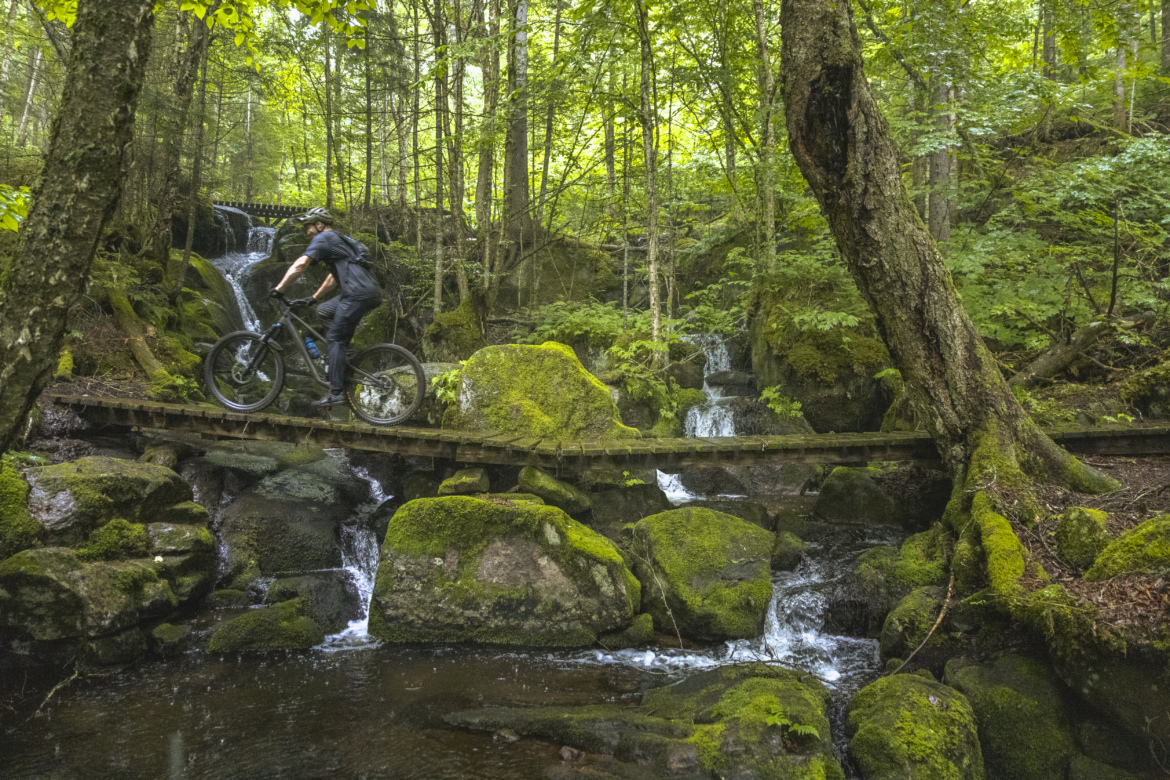
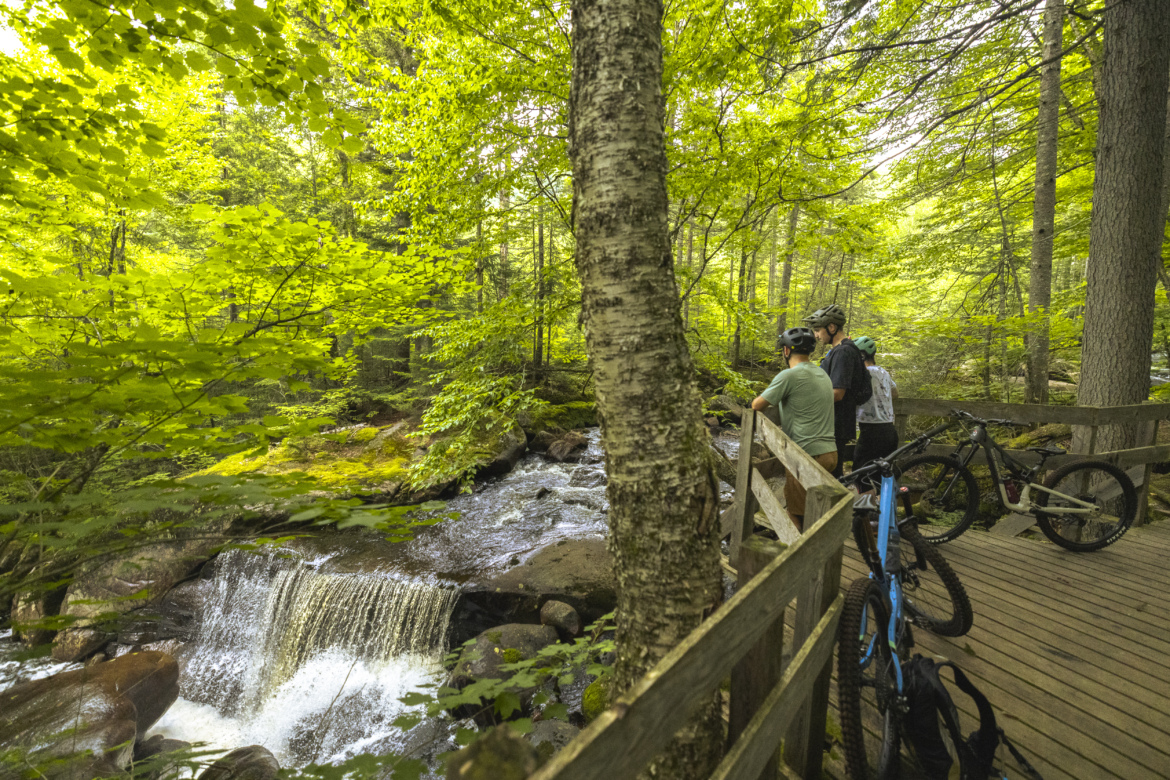
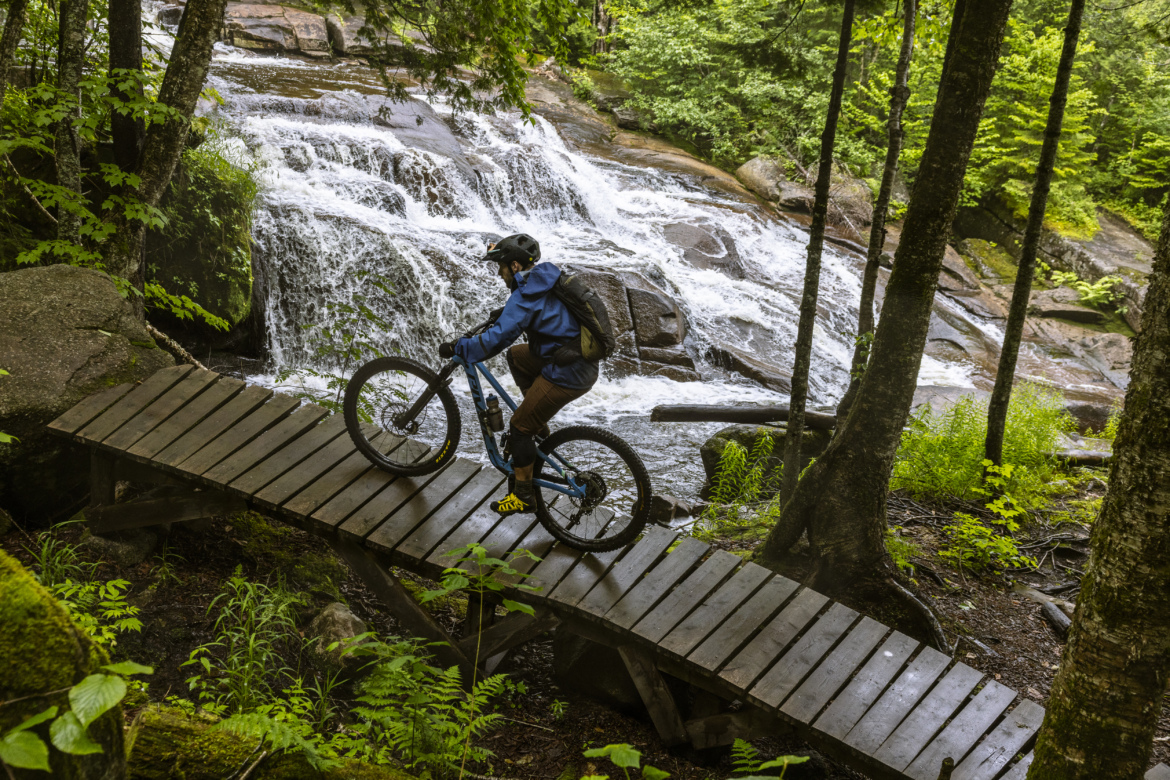
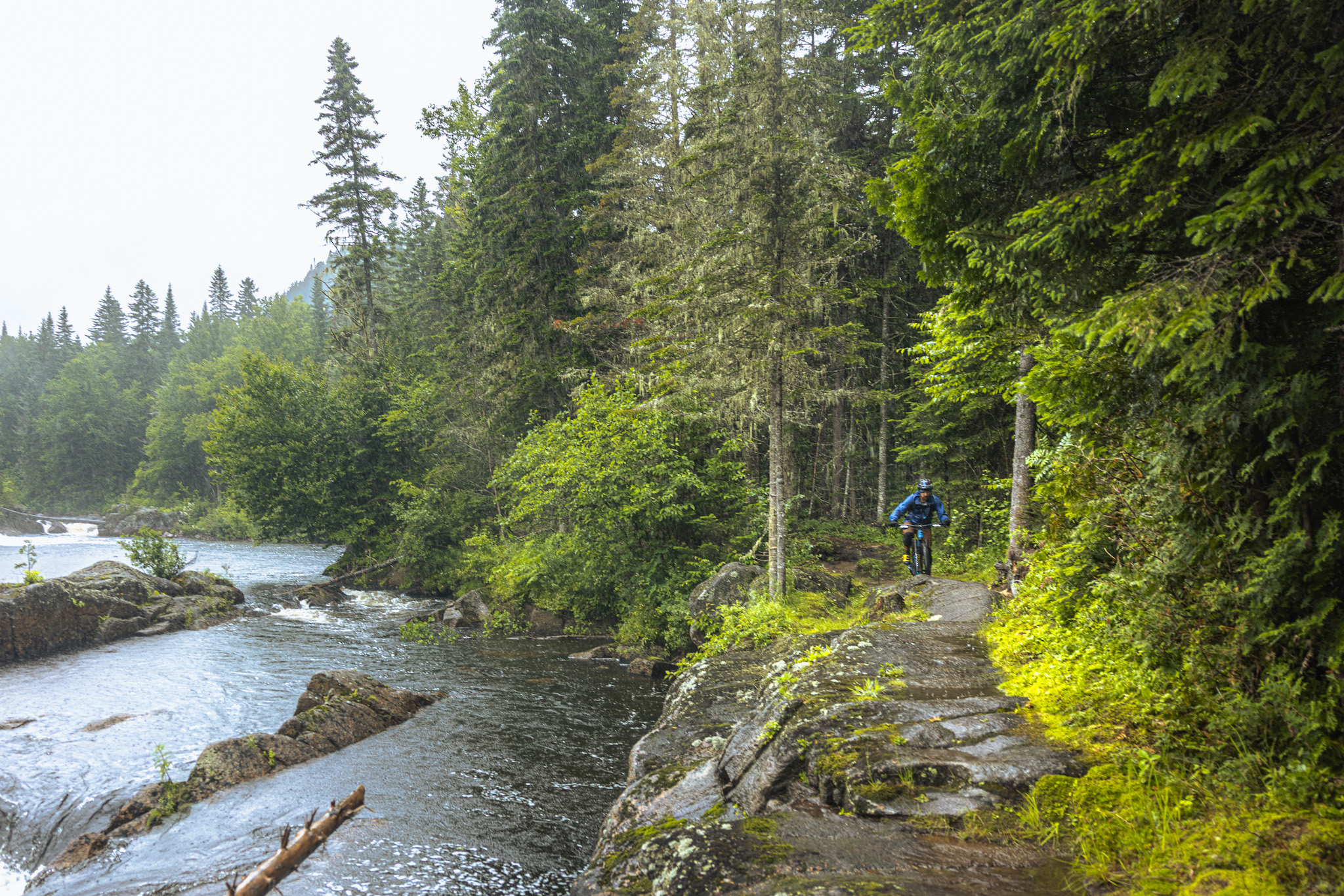
For legendary backcountry riding, the Three Neilsons reign supreme. Combining Neilson Est, Nord, and Sud into a black diamond backcountry loop will take you on an epic adventure through the mountains and river valleys of VBN’s Shannahan Sector. The trails are rugged and old-school, filled with technical challenges. But more than anything, the beauty is unparalleled! You’ll pass thundering waterfalls and pedal along the whitewater rapids of the Neilson River, which are popular with whitewater kayakers.
If you still have legs, go pedal the Légende. This renowned trail features a brutally technical but unbelievably beautiful rock-work downhill along the banks of yet another raging mountain stream. The technicality and beauty of this trail make it an iconic photo stop and a filming location for numerous YouTubers. Just don’t try to ride it in high water, as the trail gets flooded out.
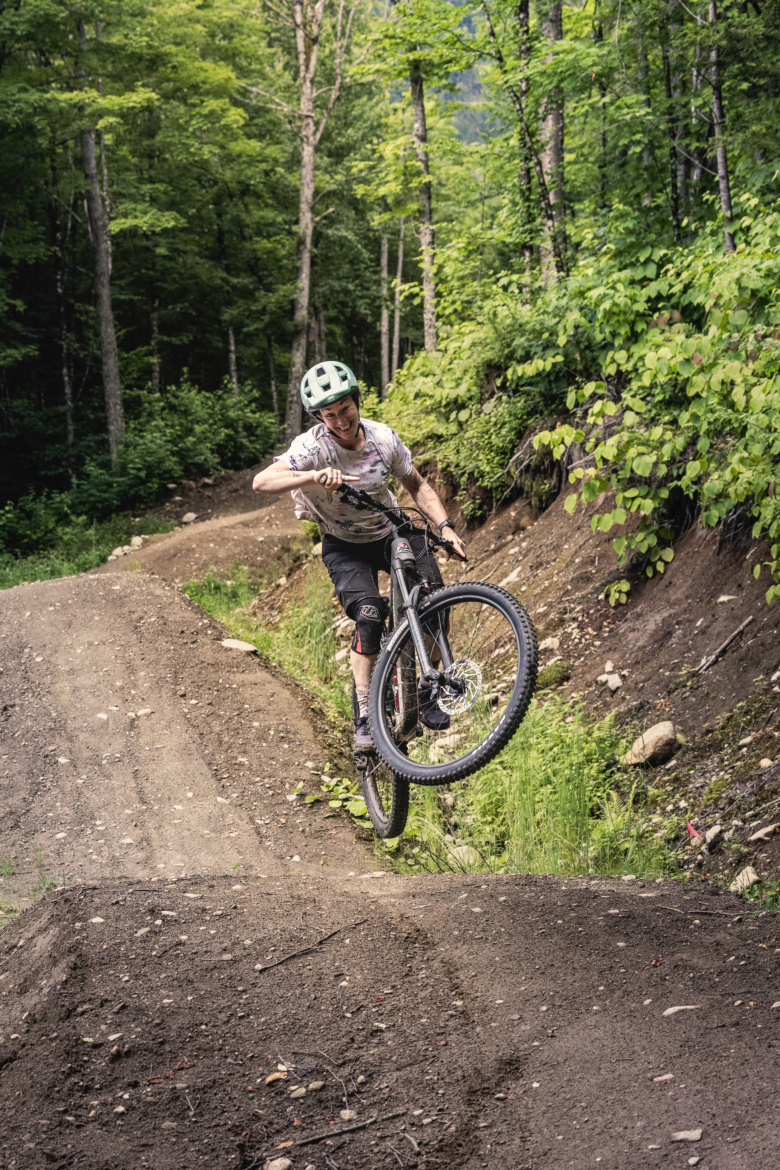
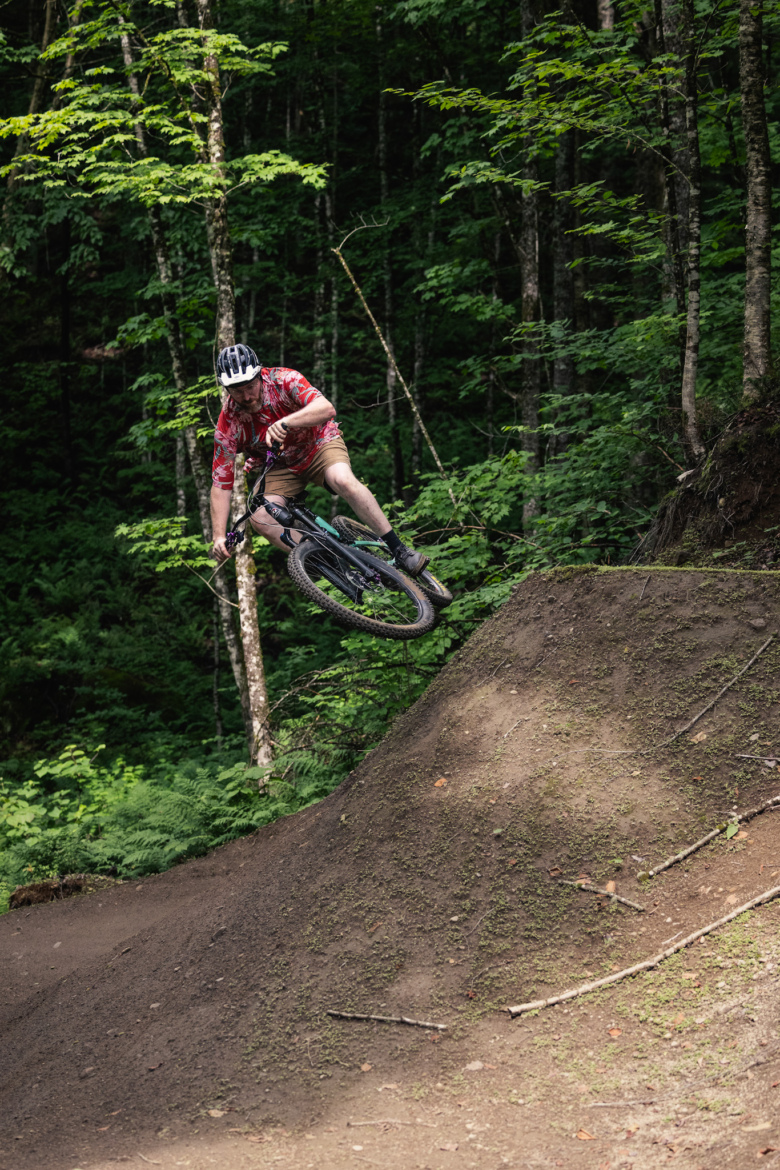
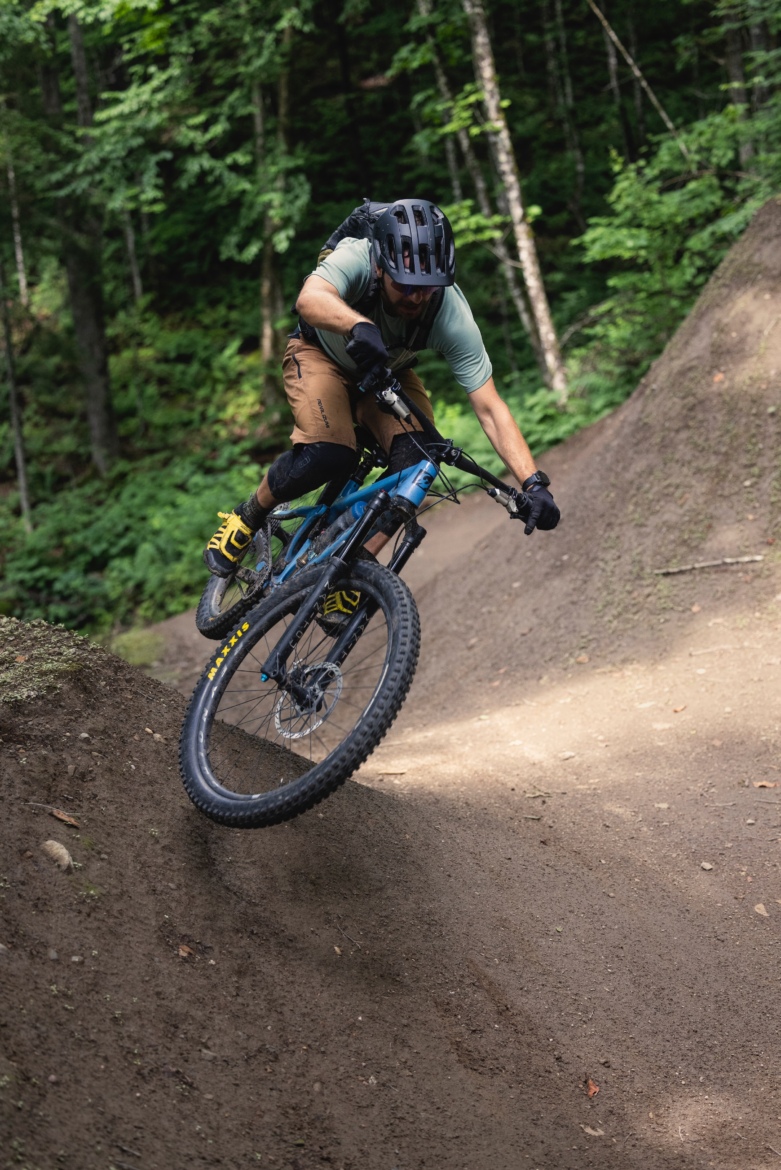
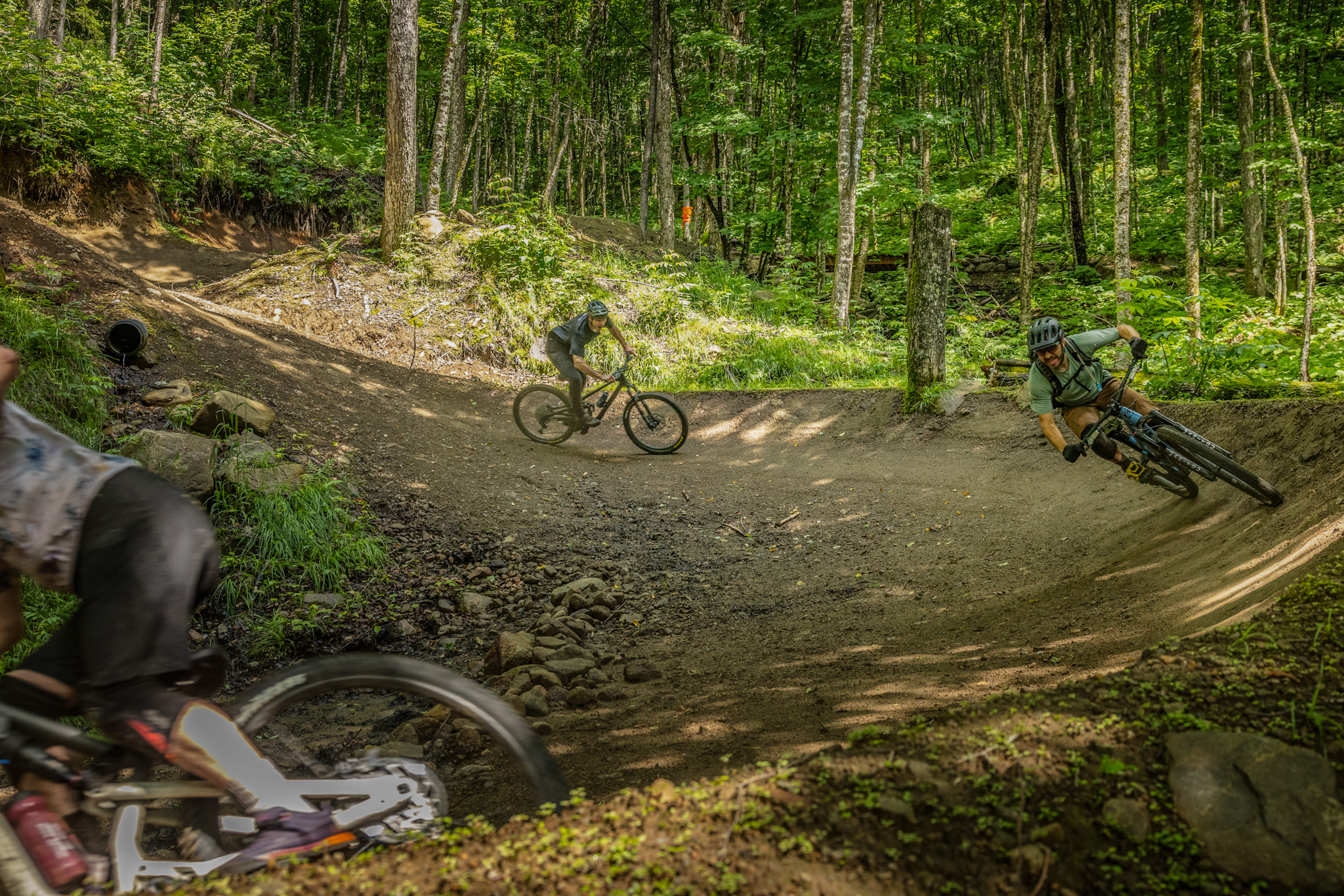
While VBN is best known for its backcountry singletrack, it’s now making a name for itself with its gravity sector, too. The Godzilla jump trail features A-Line-size jumps built by the renowned Gravity Logic crew. For those who don’t want to send 40-foot tables, the adjacent Octopus and Kraken trails offer intermediate-level flow trails. These lines are decidedly not jump trails, but the perfectly sculpted terrain, massive berms, and flowing rollers through a beautiful forest made this downhill one of the best flow trails I’ve ridden anywhere in the world.
Finally, VBN also boasts an additional network of trails that’s rideable from nearby downtown Saint-Raymond. While these trails don’t offer the remote backcountry experience that VBN is known for, the convenient access and high-quality trail building shouldn’t be overlooked.
An adult day pass costs $23.40 CAD.
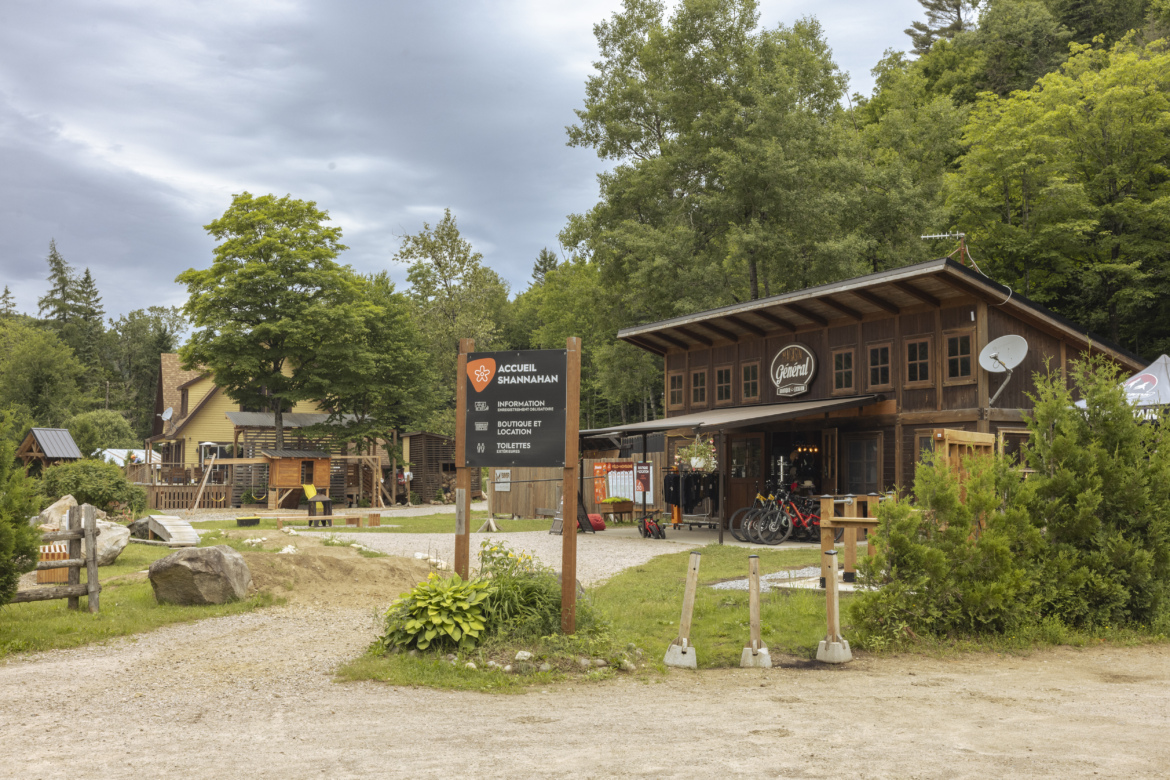
Off the bike in Vallée Bras du Nord
Along with MSA, VBN is one of only two Quebec City trail systems that offer convenient camping directly adjacent to the trails. The campground even features a van-specific section for the #vanlifers among us. You can park your van for a weekend (or longer) and never move it, riding epic loops directly from camp. They also offer yurts and small cabins.
VBN boasts a host of other amenities, especially at the Shannahan Sector, including a gift shop/general store (with snacks), a bar, and a bike wash. There’s also a complete bike shop on site with supplies for sale, mechanics conducting quick repairs, and a rental fleet of bikes.
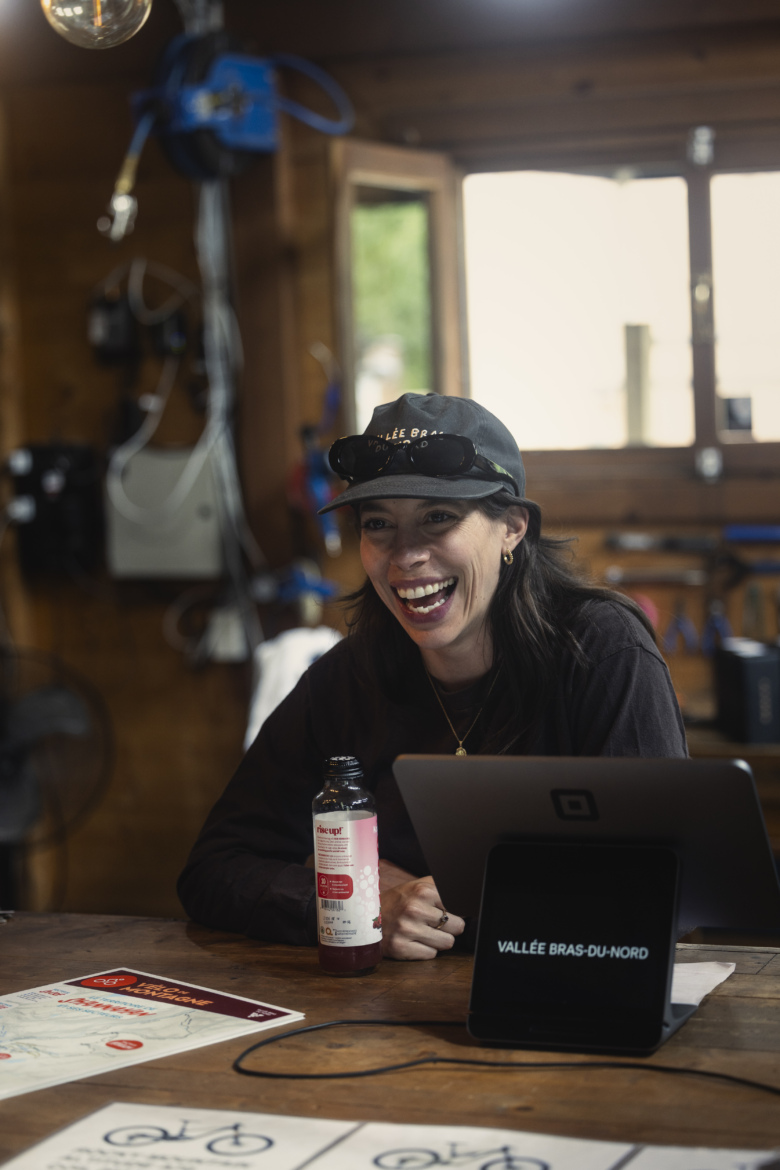
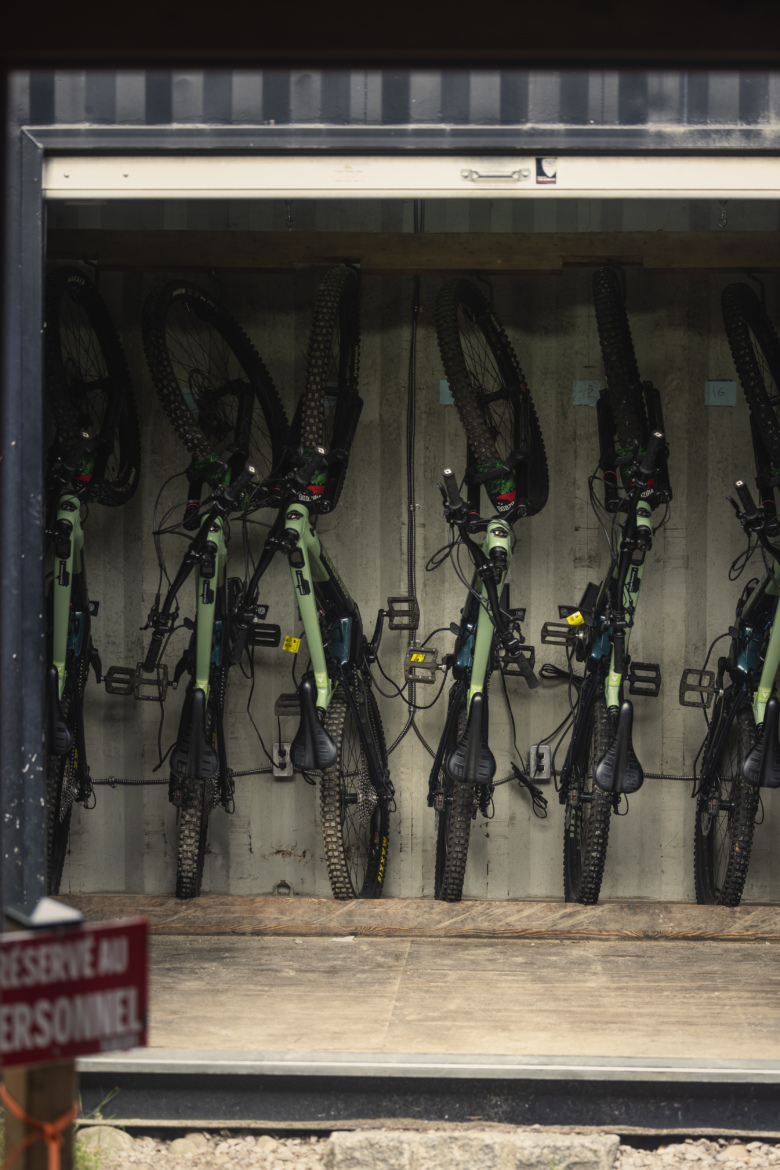
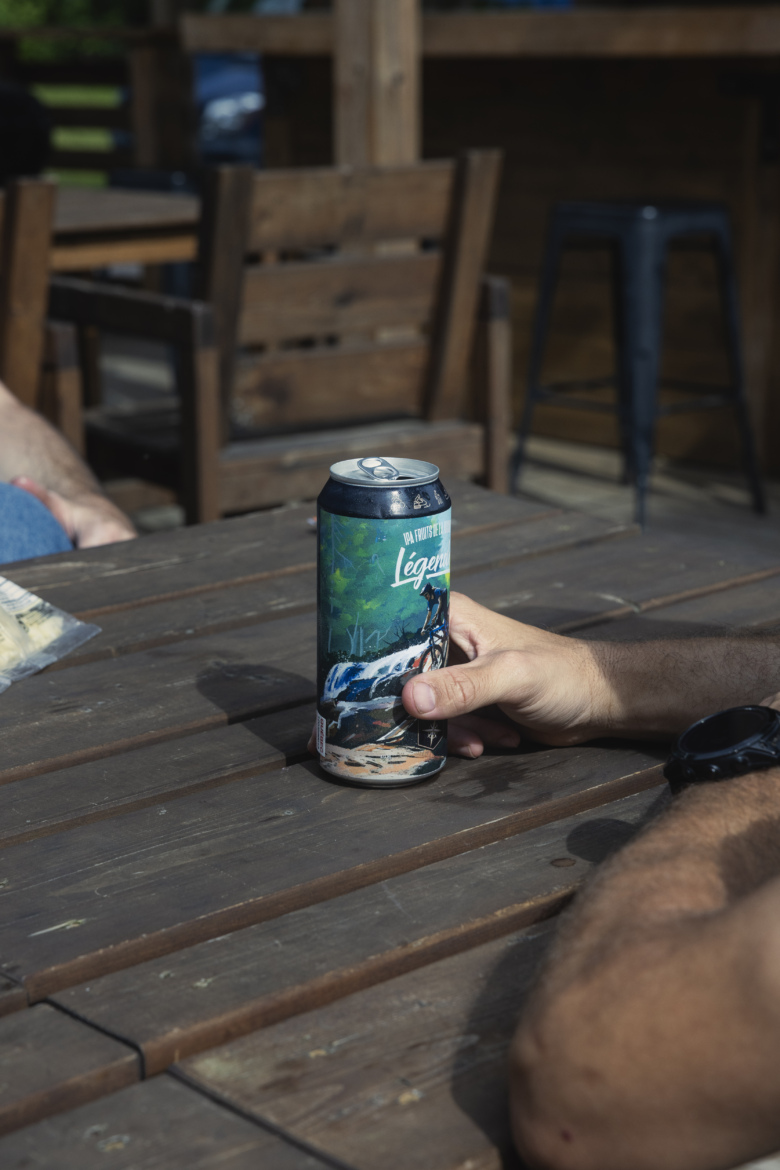
For those who don’t want to camp, the Roquemont Hotel in Saint Raymond should be your go-to stop. This comfortable hotel is directly adjacent to the Saint-Raymond Sector trails, offering mountain biking straight from your hotel room. Roquemont offers both hotel rooms and small cabins for rent. As an added bonus, the Roquemont Restaurant, directly adjacent to the hotel, is one of the best in Saint-Raymond.
Finally, if you want to do more than just mountain biking on your trip, VBN is the best destination in Quebec City for a multi-sport adventure. In addition to mountain biking, VBN offers canoeing and kayaking (including legit whitewater runs), canyoneering, rock climbing, a via ferrata, and hiking.
Sentiers du Moulin: Technical rock slabs galore
I hurriedly clipped into my pedals and made sure to drop in right on Julien’s wheel. The general manager of Sentiers du Moulin had already shown himself to be an accomplished rider, so I trusted him to show me the ideal line through the mess of rock slabs, roots, wooden bridges, tight corners, and drops on one of the network’s many demanding trails. I was thankful I had brought my enduro bike to Quebec, as I used every bit of my suspension and punished my wheels while blasting through holes in the rocks and smacking the occasional sharp edge.
“The technical level of riding is quite high,” said Julien Levesque, General Manager of Sentiers du Moulin. “It shows in the trails. I’d say maybe a third, or maybe more than that, are double blacks.”
“You hit the ground with a shovel, and you’ll probably hit a rock,” Levesque added, saying that the rock is “a little bit like the rock in Squamish — so big rock slabs, but you can control your speed pretty easily.”
Thanks to this technical, demanding riding located close to downtown Quebec City, Sentiers du Moulin (SDM) is arguably the most popular mountain bike trail system in Quebec. Indeed, on the day I visited, all four expansive parking lots were filled to capacity, and cars were parked down the road for over a mile. Even as people finished up their rides and left, other riders flowed into the parking lot, quickly filling the vacated spaces.
Generally speaking, the expansive 65km (40mi) of one-way mountain bike trails spreads riders out and keeps the crowds from feeling too oppressive. However, a new trail — Saga — had just opened a few weeks before, and it seemed like everyone had the same idea: go ride the new line.
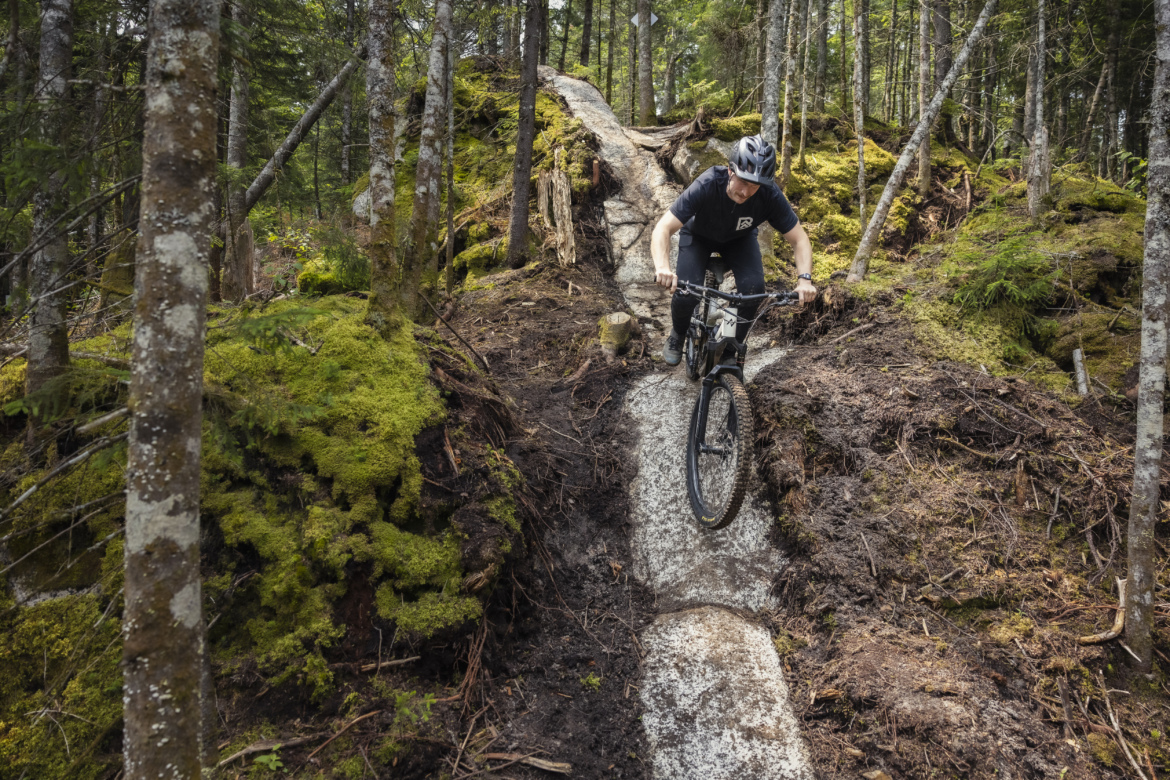
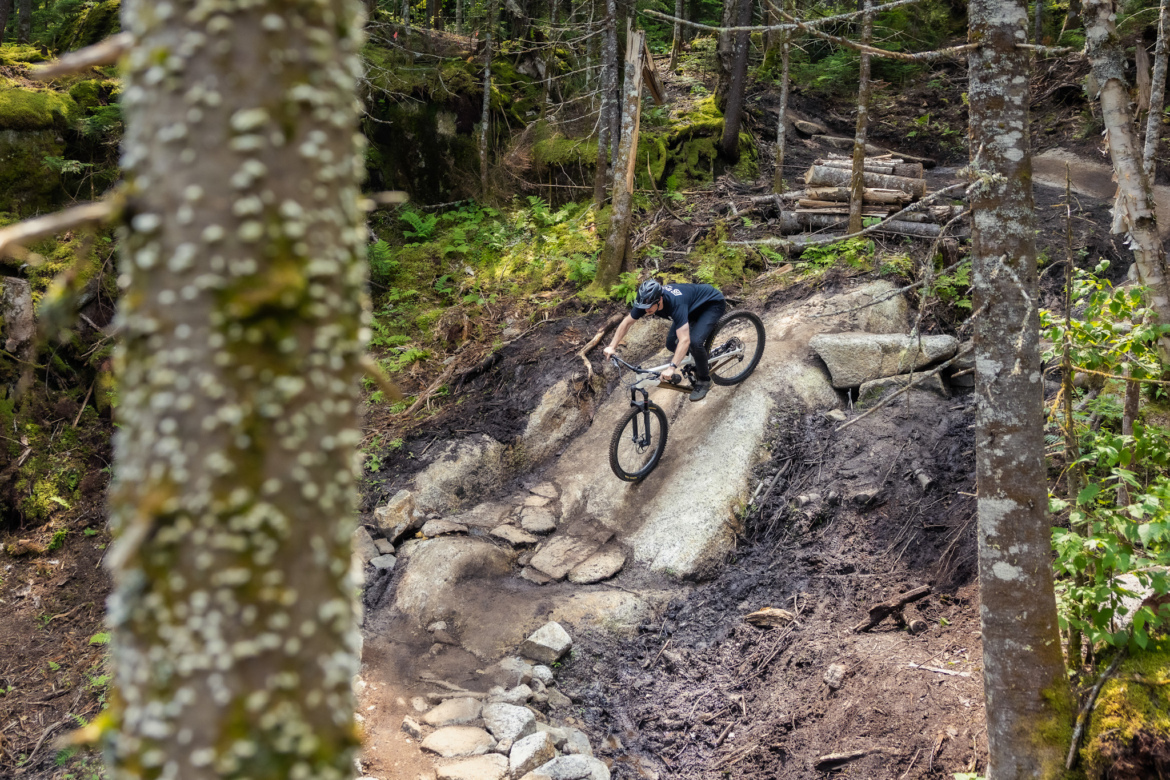
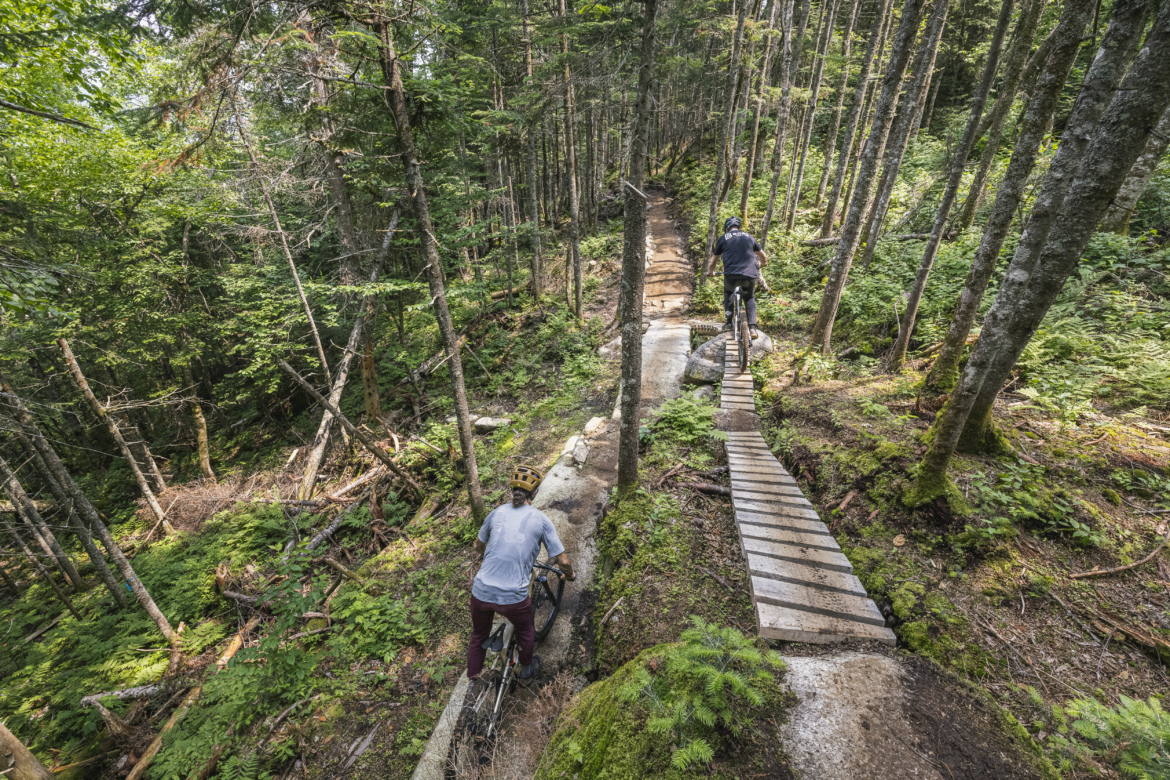
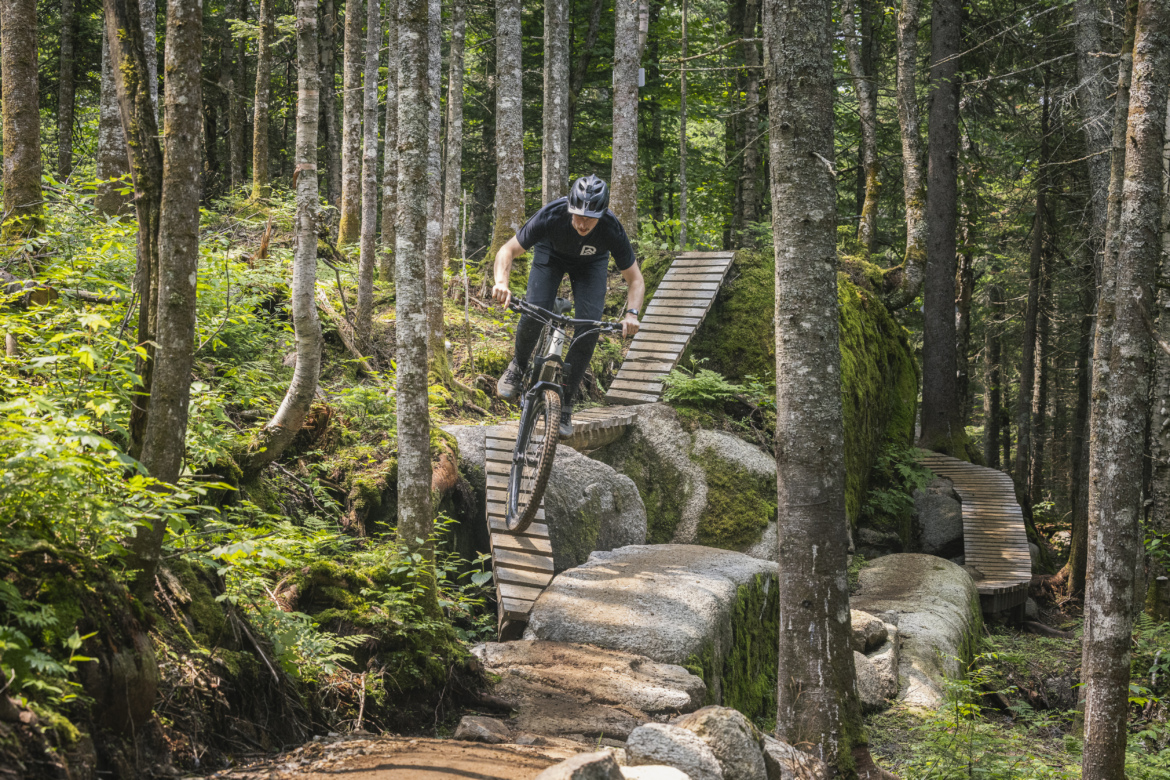
Saga was packed with conga lines of riders trying their hand at the endless cascade of technical features: steep rock slab rolls, gnarly rock gardens, slick root webs, skinny wooden bridges, and more. At 4.2km (2.6mi) long and dropping 237 vertical meters (779ft), this new build is one of the longest single trails at SDM. When you drop into Saga, it’s a true commitment, as there are no bailout options and no easy lines. The signs and squirrel catcher features at the top tried their best to keep unprepared riders out of the trail, yet we still saw some riders walking down rocks within the first kilometer. They were in for a long and unpleasant day.
The new line receives a single black diamond rating, but it falls on the darker end of the spectrum. Throughout the descent, numerous double black line options are available, and there’s even one “pro line” descent, which I wanted absolutely no part of. So, essentially, single black is the easiest it gets on Saga — it only gets more difficult from there.
But just how hard of a single black is it? I’ve written extensively about the difficulty of rating mountain bike trails consistently, but if you’ve ridden single black diamonds in Squamish or on the Whistler Westside, you can compare Saga to those trails. Most places in the USA, this trail simply wouldn’t get built. It’s that gnarly.
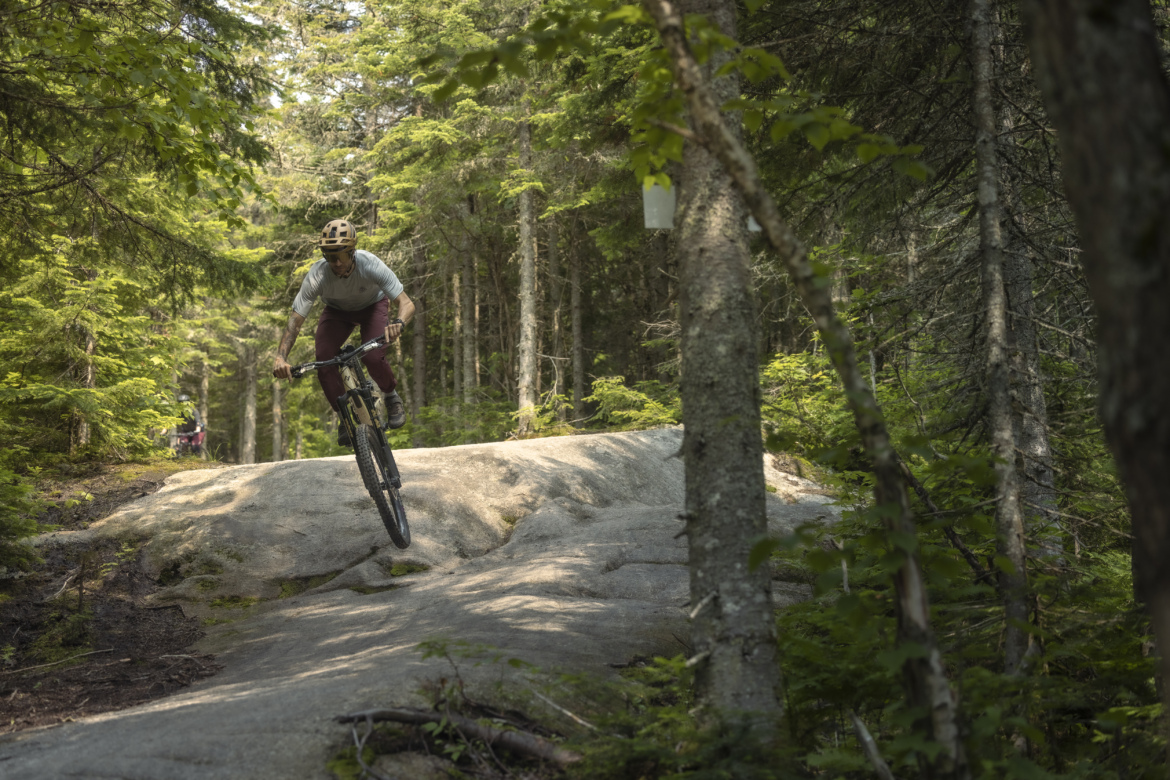
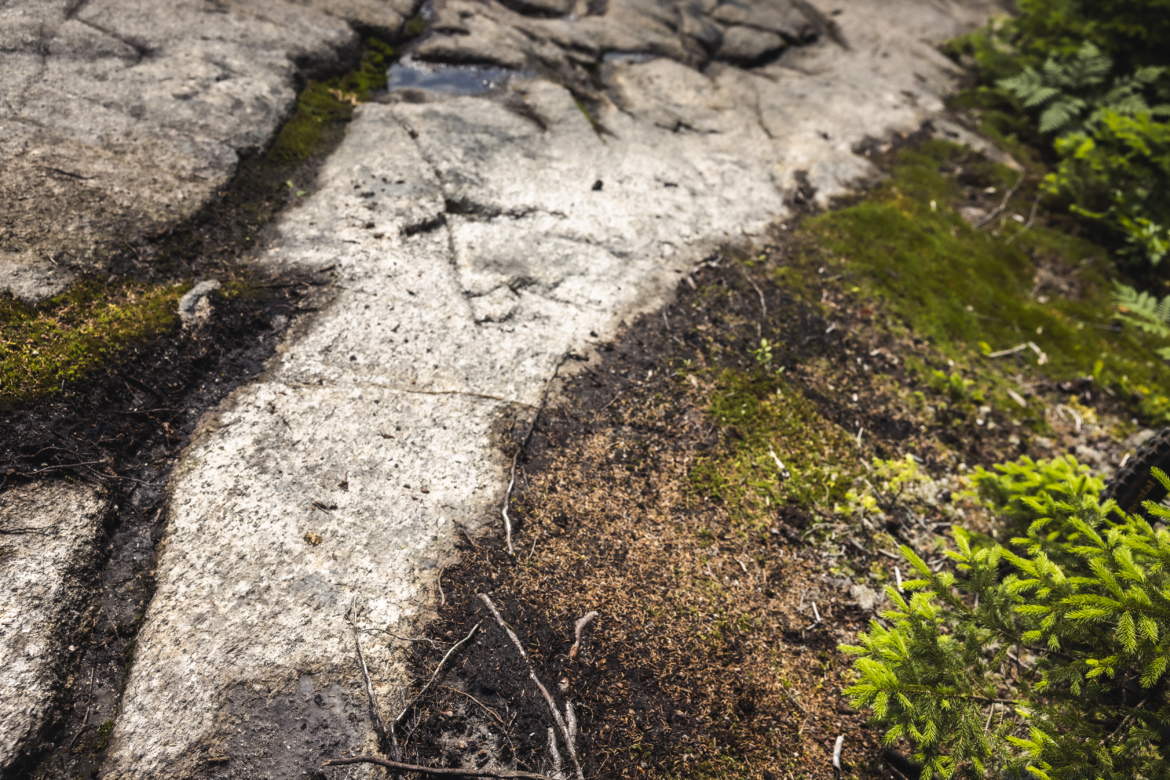
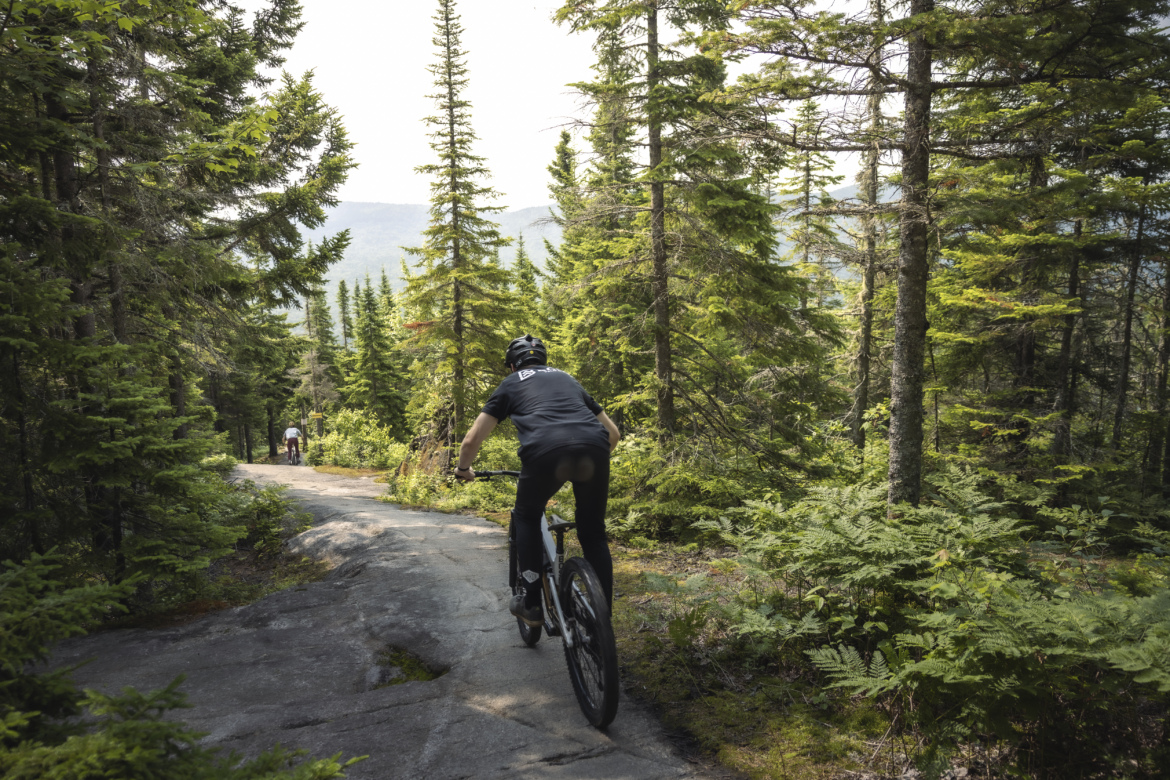
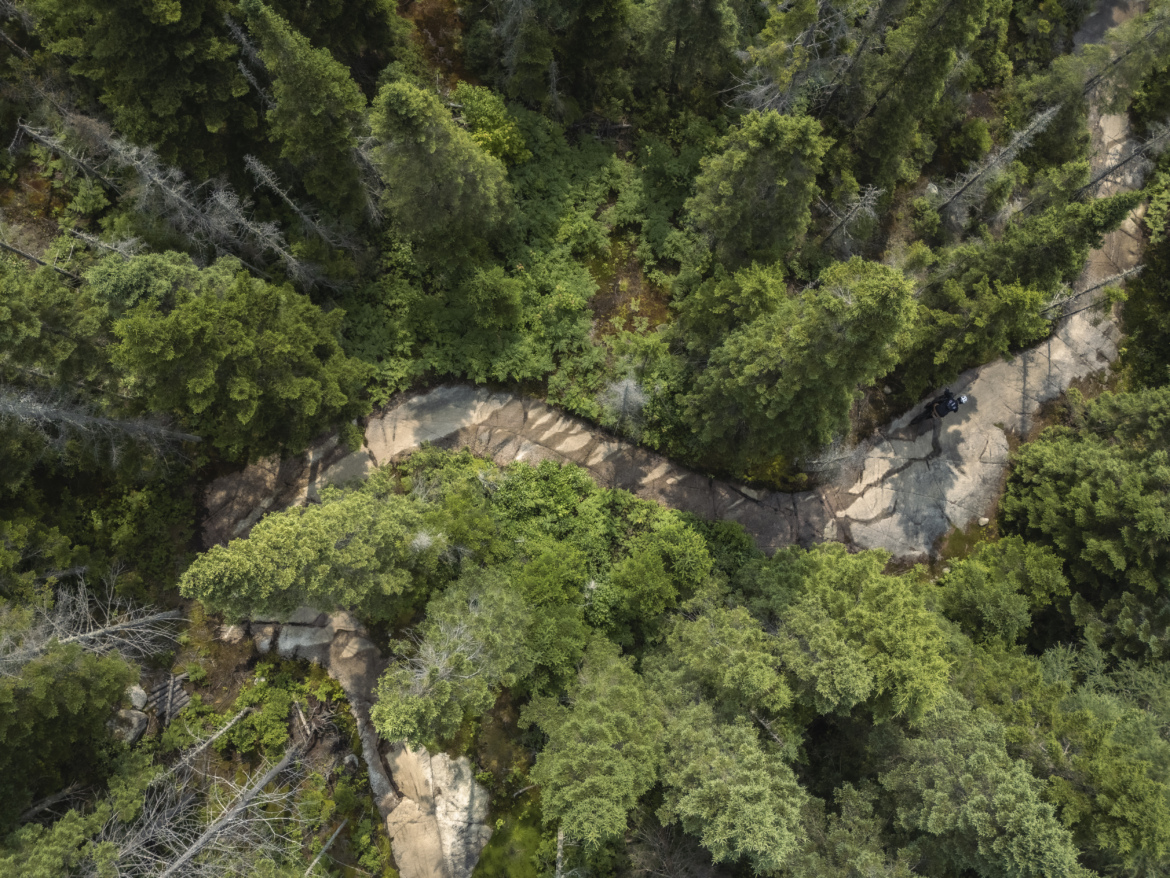
Slab City is another of SDM’s stand out trails. Also rated single black, this raucous descent follows an endless cascade of exposed rock slabs. Essentially, you’re rolling on rock for the entire 1.3km (4,400 linear feet) descent.
The trail network is densest on the other side of the road, close to the SDM trailhead. In this zone, you’ll find SuperG. SuperG is likely the most popular trail in the system, offering a flowy descent with big berms, jumps, and drops. But in true SDM fashion, there are several exposed rock slabs and rock drops mixed in.
I also rode Mammouth, one of the easiest double black trails on the mountain. After that, I took a look at the squirrel catcher rock slab roll on LBC 2 (the next step up), and I decided I was good.
SDM also offers a few intermediate descents from the main hub, and a few pedal-forward trails along the base, but it isn’t known for offering a very progressive trail system. The leap from the easy trails at SDM to the black diamonds is substantial. Levesque said that they are trying to address this gap with future trail builds, but for the time being, riders looking to progress their skills will want to ride trail systems like Empire 47.
A day ticket at SDM costs $24 CAD, and e-bikes are charged 25% more due to the additional wear and tear on the trails.
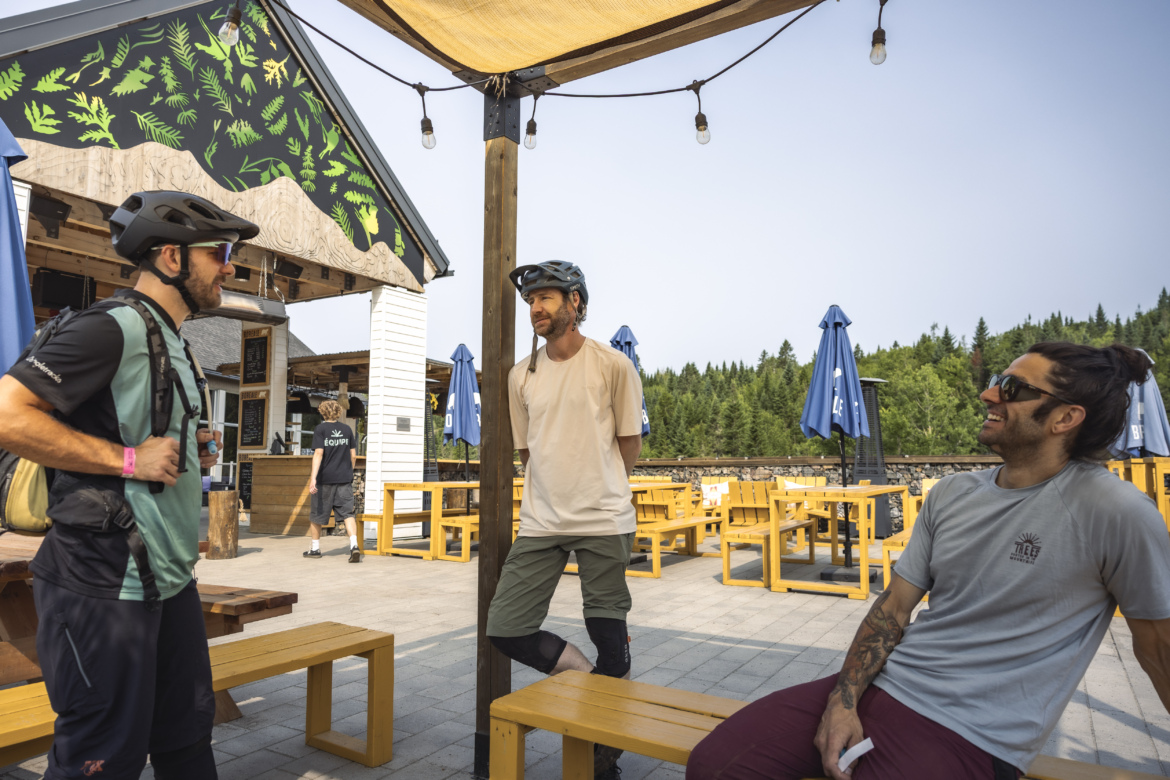
Off the bike near Sentiers du Moulin
Of all the pedal-driven trail systems I visited, the base area at Sentiers du Moulin was the most impressive. The trail center utilizes a beautiful base lodge owned by the local city to run a fantastic restaurant and bar.
The operation at SDM is massive: Levesque manages a team of 40 full-time employees, plus 20 part-time employees during the summer. They employ 10 full-time trail builders give or take, and even still, much of the trail building is conducted by volunteers in collaboration with the paid pros. SDM sells between 25,000 and 30,000 day tickets per summer season, which doesn’t include all the rides conducted by season pass holders.
In addition to Levesque’s team, the nearby bike shop, Genetik, runs a full repair and rental shop location out of the base lodge in addition to their primary operation. I had some problems with my bike, and they fixed them quickly while I waited to keep my trip rolling along smoothly.
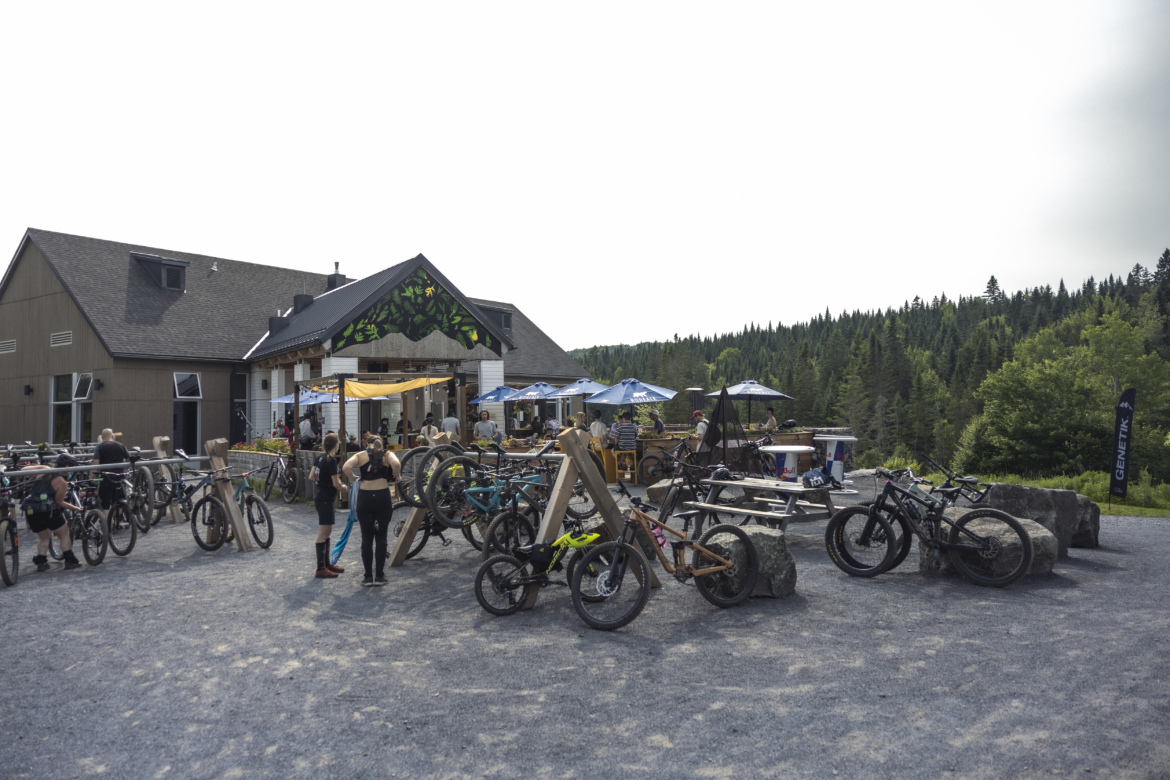
For nearby lodging, be sure to check out the Entourage Sur-Le-Lac. Located just 5.3km (3.3mi) down the road, you can easily pedal to SDM if you don’t feel like dealing with the parking madness. This gorgeous resort is situated directly on Lac Beauport, with a private sand beach for swimming (and a swimming pool, if the lake is too cold). They also have a dock with numerous paddling options tied up, such as paddleboards, canoes, and kayaks, all of which are free to use if you’re staying at the hotel. The hotel’s restaurant, L’ilot, offers a delicious and diverse menu for all meals of the day, as well as a full bar and outdoor patio seating mere steps from the lakeshore.
If you don’t want to deal with driving around and the hectic pace of the city, it’s tough to beat the convenient location and luxurious relaxation of the Entourage Sur-Le-Lac.
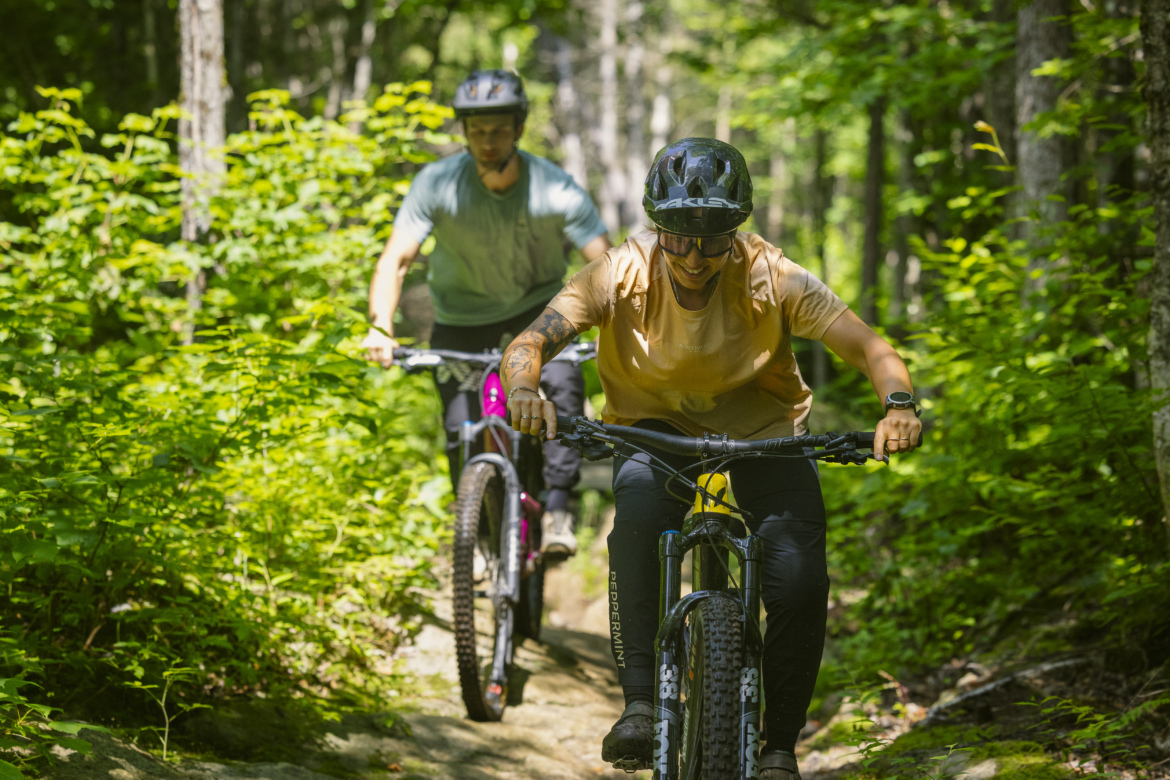
Empire 47: Trails for beginners to experts, close to the city
For trail diversity and ease of access from downtown Quebec City, Empire 47 reigns supreme. E47, as it’s colloquially known, boasts 70km (44mi) of trails for cross-country and enduro riders.
The network is divided into a steeper, more enduro-oriented section and an XC area. In the steeper zone, trails climb up two distinct “peaks,” each offering a suite of descents to choose from. While it might not look like much from the parking lot, the peaks rise about 400m (1,312ft) above the base area, and from the top, you’ll enjoy expansive views across the region.
The steep enduro zone is home to several gnarly tech trails, like Pad Religion and Sepultura, as well as manicured flow trails like Shaman. The jump trails at E47 even reach the professional level, with Nosferatu boasting massive gaps, step-down drops, and more. From the top of the peak, you can get a good view of riders dropping the first massive wooden drop… if anyone has the guts for it.
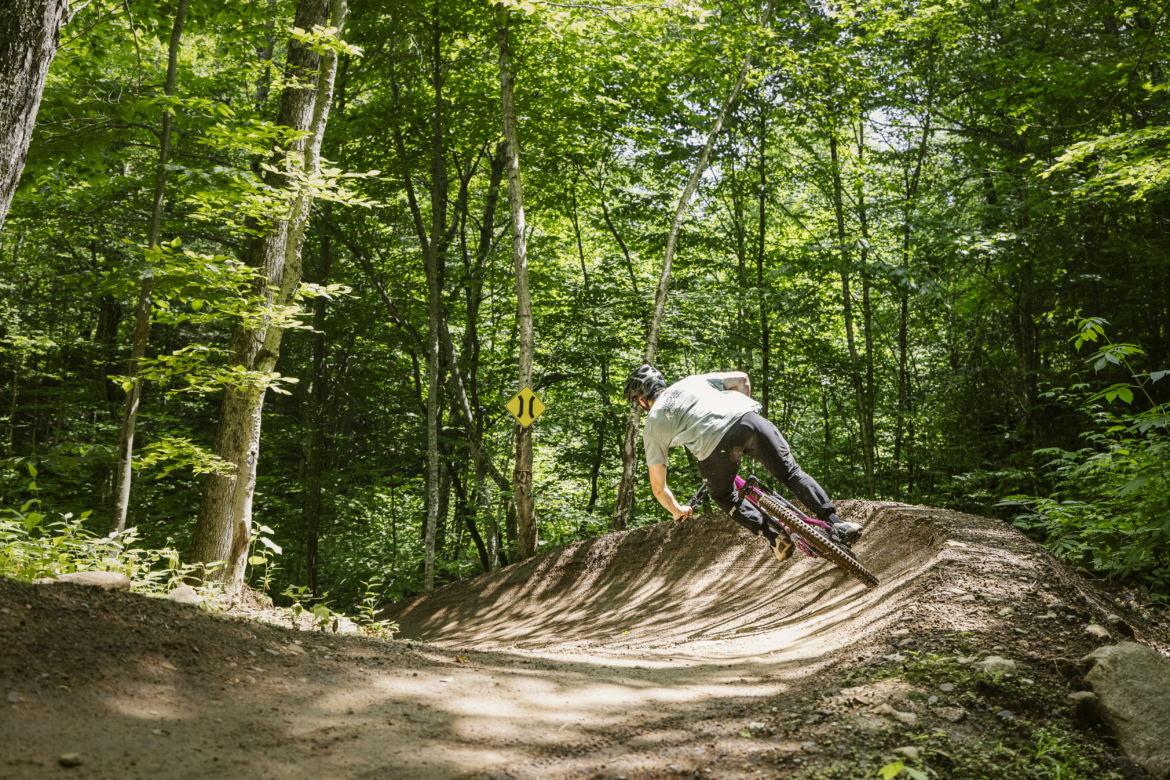
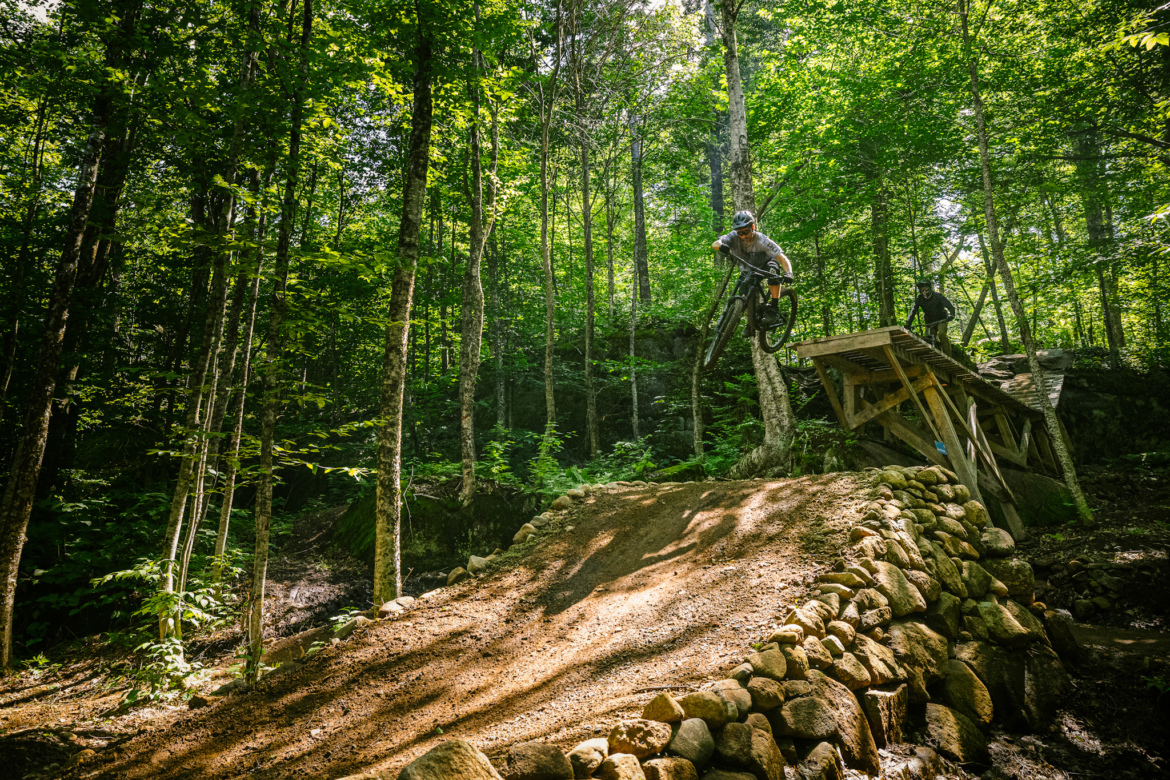
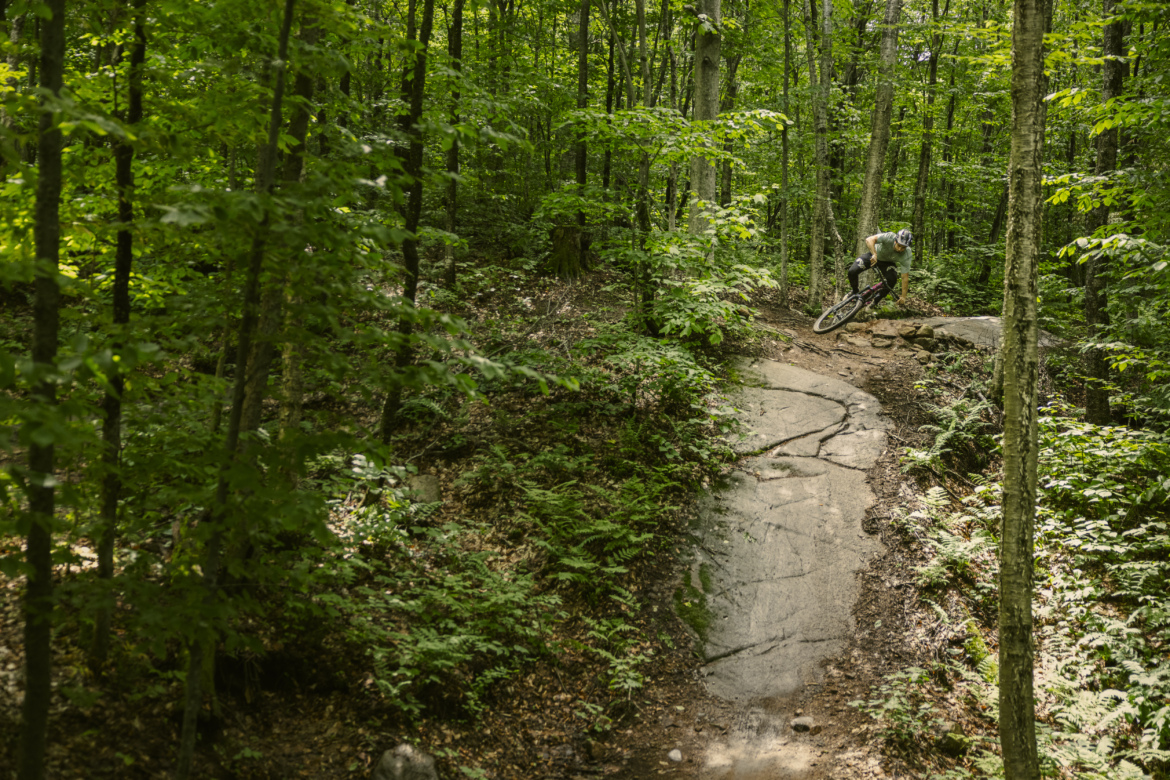
For pedal-focused trails, you can’t go wrong with Zomby Woof and Zombie Toof. Woof begins as an intermediate XC trail with a consistent climb and descent. Toof ramps up the technicality a notch, with bigger rock gardens, roots, and an extensive wooden bridge over a boggy area. The Huron trail, named after the anglicized name of the First Nation that originally inhabited the area, also offers great XC pedaling. (The nation prefers their actual name, “Wendat,” and it has been added to some trail signs.)
Pro jump lines aside, E47 offers some of the most accessible trails in the Quebec City region. It’s the best place to take young kids for a singletrack ride, or anyone new to the sport. The network boasts extensive green and blue trails running through the flat lands, which are perfect for new riders. Intermediate flow trails like Shaman offer fantastic progression opportunities, and riders have plenty of chances to build their skills and work up to the harder lines. Plus, E47 has its own mountain bike school right on site, three skills zones, and a summer program where young riders can learn, have fun, and progress.
While many of the trail systems near Quebec City offer a paved Velosolutions pump track, the pump track at E47 is the largest, at 1,800 square meters (19,375 square feet). This playground is the perfect place for kids and adults alike to hone their skills.
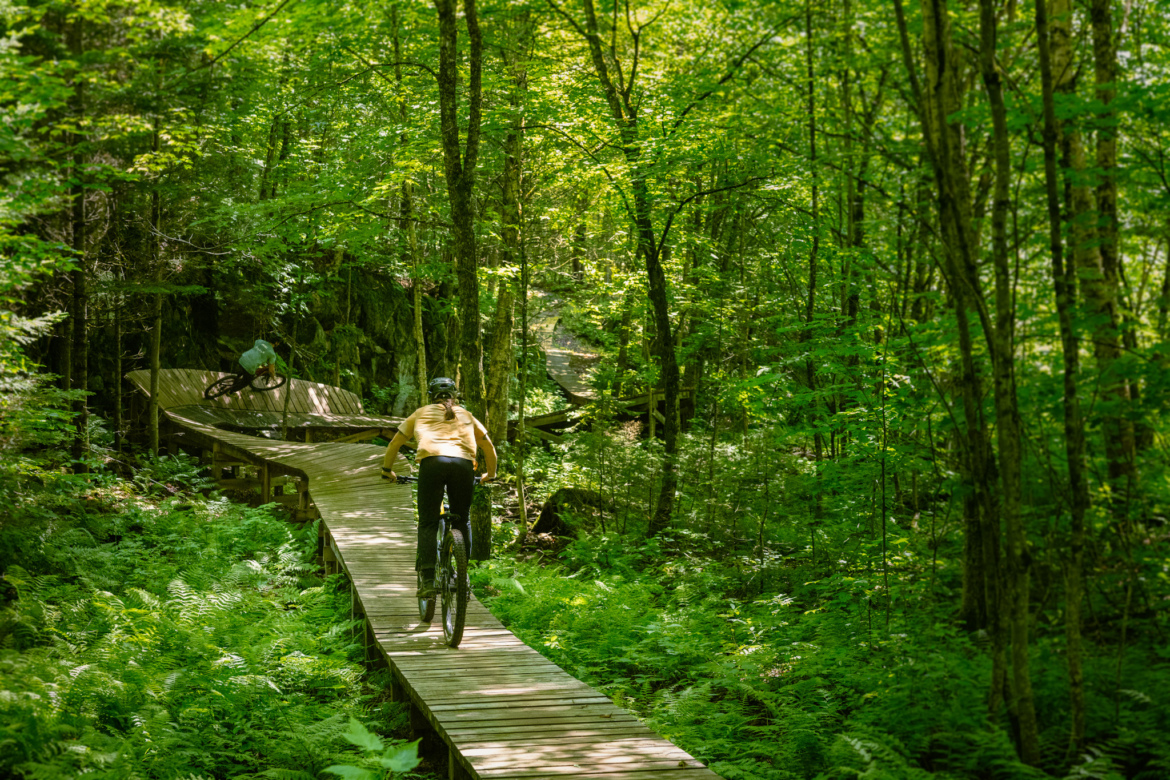
The network also routinely hosts competitive events, such as the XTERRA Off-Road Triathlon. The location is ideal, thanks to a lake located mere steps away from the trailhead. In fact, local legend Gilles Morneau convinced the landowner to first build singletrack trails at Empire 47 so they could host an XTERRA race. Since those early days, the network has expanded to its current size and now reigns supreme as one of the most popular trail networks in Quebec.
Finally, while almost every trail network around Quebec City offers fat biking, E47 quite likely claims the superlative of “most popular fat bike destination in the world.” Morneau conducted a study five years ago, contacting popular fat biking trail systems around the world. At the time, many of the most popular fat bike networks he contacted logged 5,000 visits per season. E47 logged 18,000 visitors per season at the time, and that number is likely even bigger today.
An adult day pass at E47 costs $24 CAD.

Off the bike in Quebec City
While E47 offers a repair shop and a rental fleet (including an expansive fat bike rental fleet in the winter), it doesn’t offer the expansive restaurant-style base area amenities that you’ll find at other places in Quebec. That said, the massive parking lot is directly adjacent to the small town of Lac-Delage.
E47 is arguably the closest trail network to downtown Quebec City, although Sentiers du Moulin can contend as well. So, for lodging and dining during your E47 visit, consider basing out of the beautiful and historic downtown Quebec City.
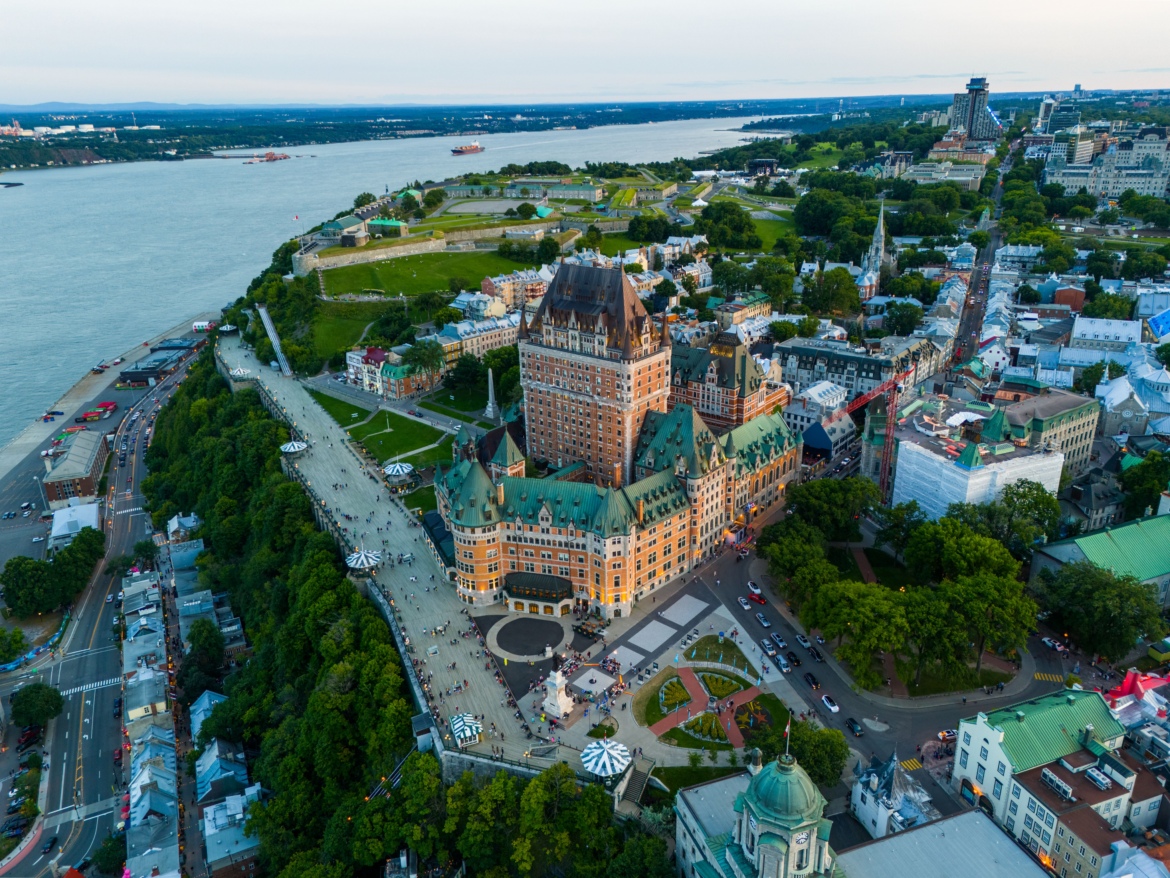
The most iconic hotel in Quebec City is the castle hotel Fairmont Le Chateau Frontenac. The towering hotel is topped with turrets and spires and is visible from miles around. Built in 1893, it offers prestigious 5-star accommodations and fine dining. If you want to add a dose of pure luxury and history to your trip, consider staying at the Chateau Frontenac.
The dining options in Quebec City are top-tier and seemingly endless. The city offers an impressive array of Michelin-starred and Michelin-recommended restaurants, including one of only two 2-star restaurants in Canada: Taniére. I can personally add my recommendation to Michelin’s for La Planque restaurant. In addition to exquisite cuisine, one of the lead chefs, Thomas Barry, is an accomplished enduro racer. Le Don Restaurant also comes highly recommended.
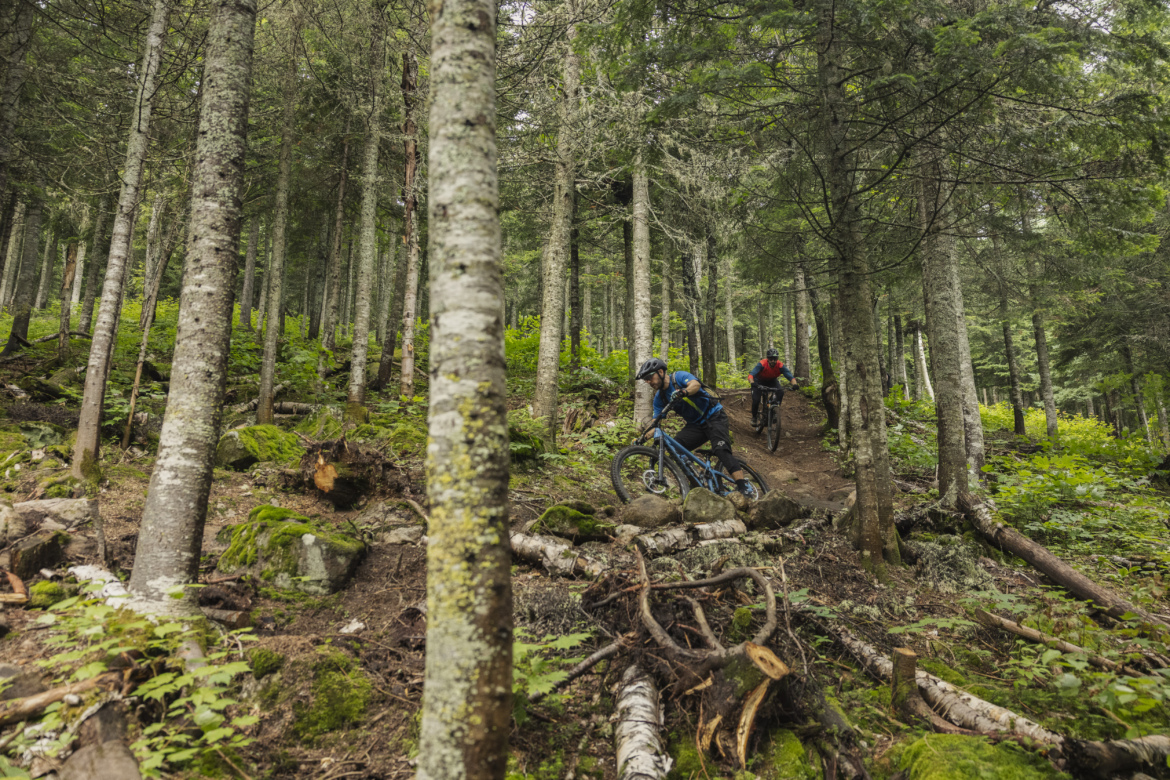
Le Massif de Charlevoix: Lift-served enduro trails with epic views
If you’ve ever wanted to rip a bike park designed for trail bikes, Le Massif de Charlevoix is for you. “Le Massif” for short, this lift-served bike park boasts 770m (2,526ft) of vert accessed by a gondola, with additional trails even higher up the mountainside that can be reached via a quick pedal.
If Le Massif is known for anything, it’s the views. The resort towers over the Saint Lawrence River, with the runs ending just above the shores of the estuary. In this area, the Saint Lawrence is mostly saltwater, and the river’s level rises and falls with the ocean tides. At the correct time of year, whales will even venture into the Saint Lawrence, although generally not as far as Le Massif. As you can imagine, the views from the trails are to die for!
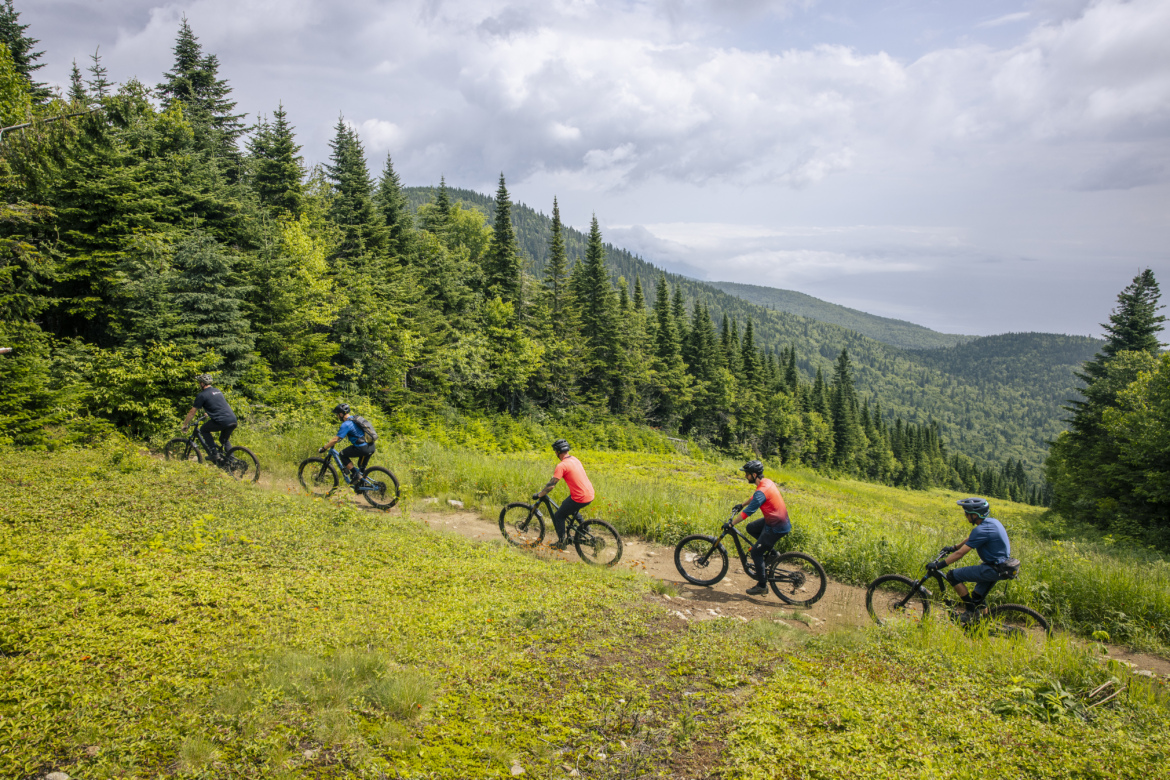
Le Massif boasts over 50km (31mi) of mountain bike trails, and for riders with the legs to pedal, the best place to start is by pedaling up from the main chalet (which is located at the top of the gondola) on the Bus Jaune trail to access either La Cigale (a black diamond) or Historie Sans Fin (a blue). Both of these natural, enduro-style trails rip down the mountainside through a beautiful forest that’s out of bounds during the winter months. I rode Cigale, and found the trail to be filled with wet, slippery roots, rugged rock gardens, and massive rock features, including optional slab rolls.
After another quick climb, the trail drops straight into La Fourmi, to continue the black diamond descent down the mountainside. Soon, the route joins the “bike park” trails, and riders will find more berms, jumps, and manicured features.
I put the words “bike park” in quotes, because even the trails that are accessible directly from the top of the gondola without a substantial pedal are still quite pedally. It’s common to pedal to make a connection across the mountainside, or even in the middle of some of the green trails.
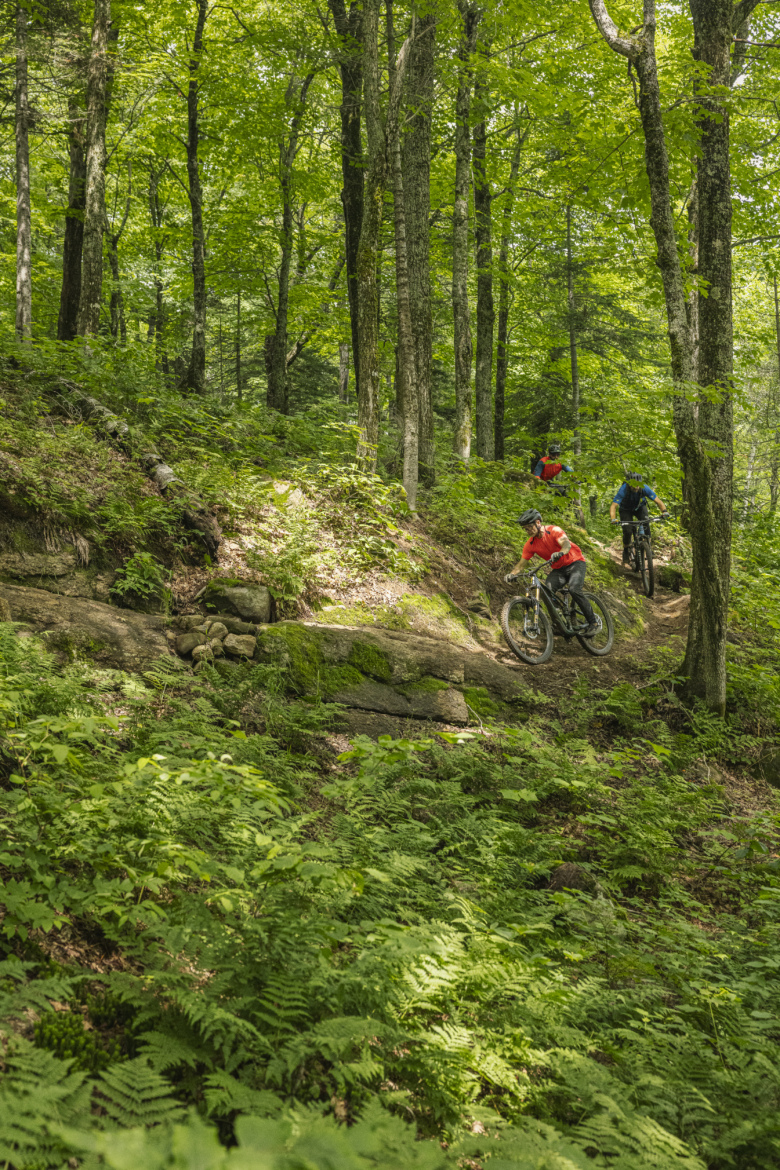
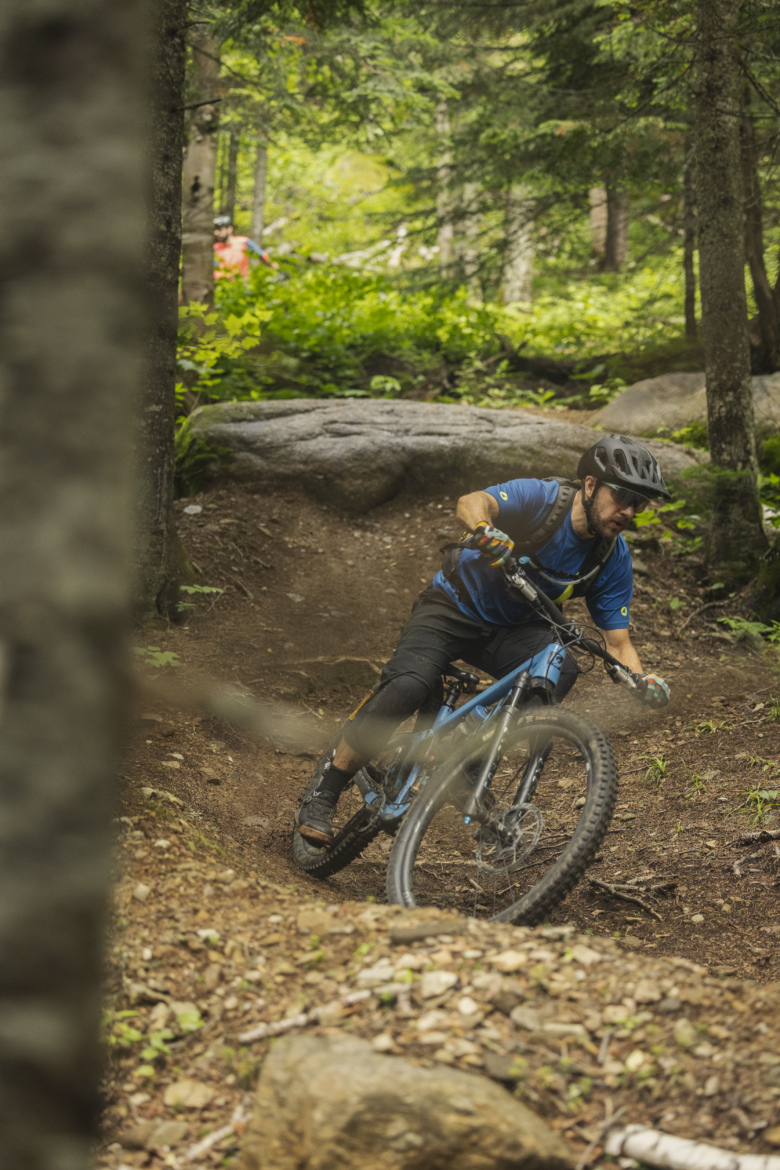
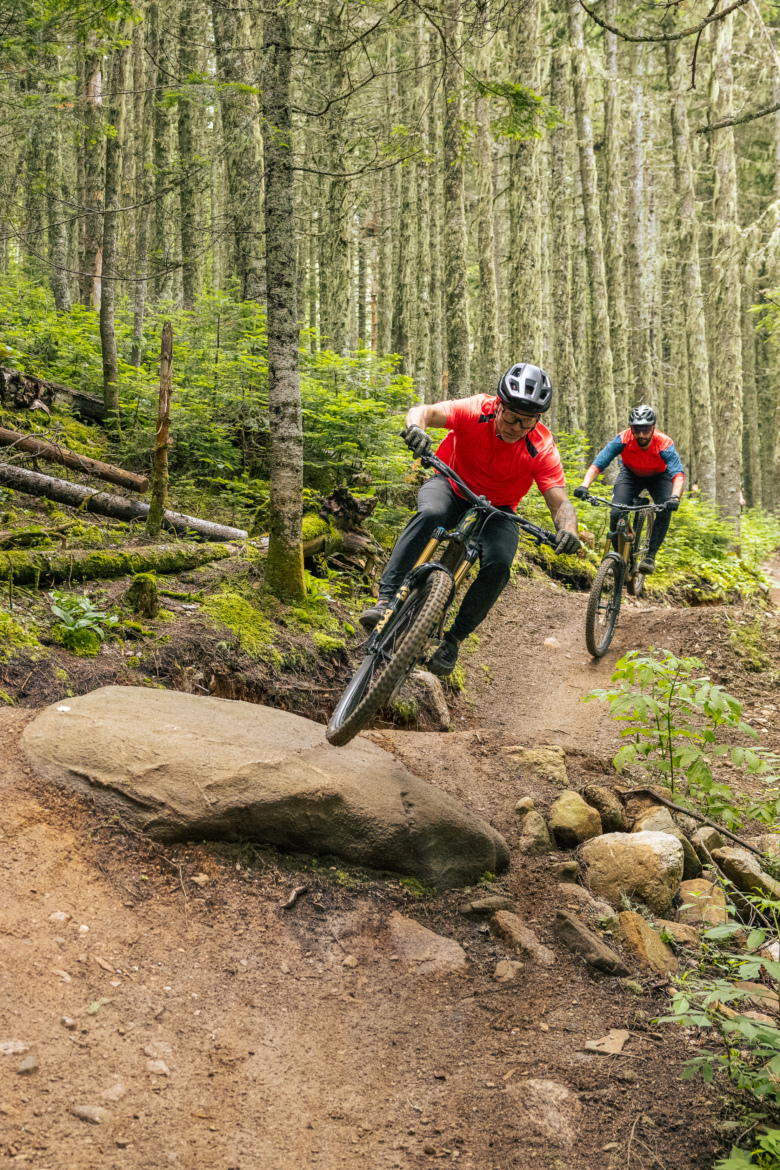
If you’re looking for manicured jump lines, look elsewhere. Le Massif’s trails have plenty of drops, jumps, and little booters sprinkled throughout, but those jumps are situated in between the omnipresent rock slabs and rock gardens. The trails here are a true blend of natural obstacles and man-made features, requiring a diverse skill set to master.
Even so, trails like Funky Fungi, Basilic, and Pesto are crowd-pleasers that can be negotiated by most intermediate riders, but will reward advanced riders who can send the side hits and carry speed well. In fact, the vast majority of the trails at Le Massif are intermediate-friendly, which is a distinct departure from the world-class downhill race tracks at Mont-Sainte-Anne. If you’re riding a trail or enduro bike, and you want to shred a few lift-served laps without risking life and limb, Le Massif is your best bet.
A day ticket at Le Massif costs $66 CAD.
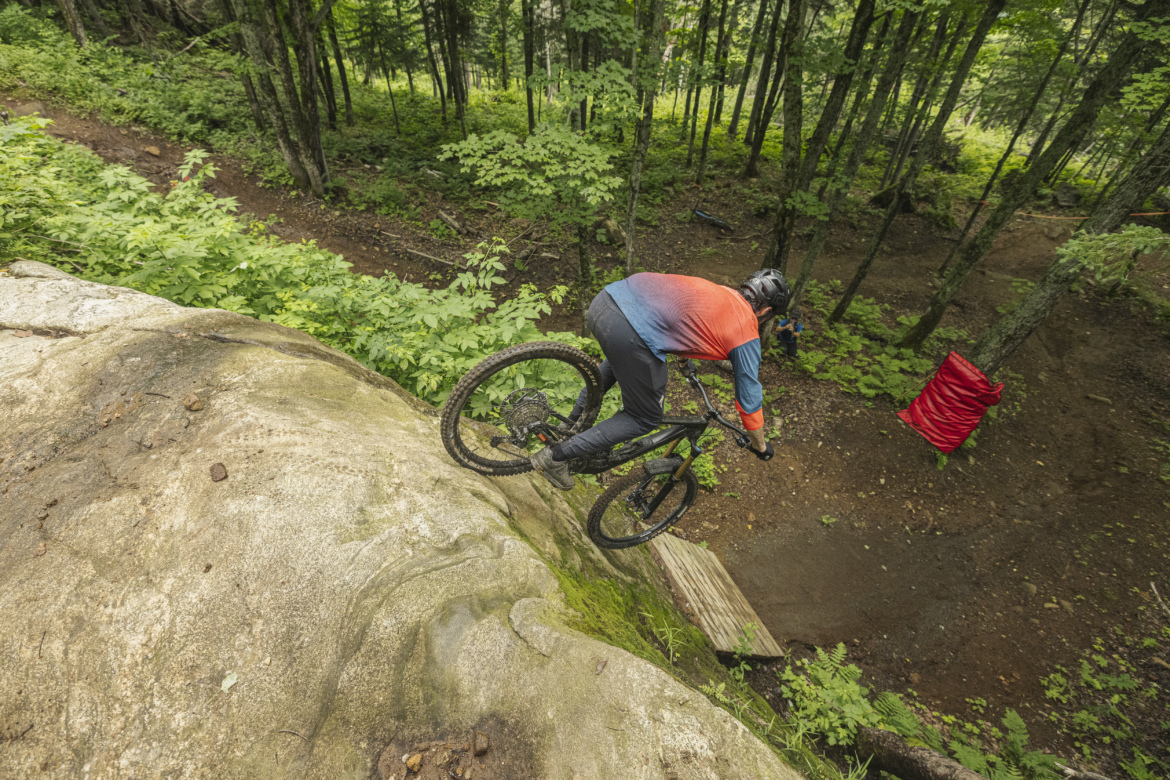
Off the bike in Le Massif and Baie-Saint-Paul
Of all five major trail systems, Le Massif is the furthest from downtown Quebec City, at just over an hour’s drive. As a result, aside from the resort infrastructure, there’s little around Le Massif.
At the resort, you’ll find a full rental fleet and a bike shop, with a restaurant at the main lodge. If you’d like to stay nearby and have a penchant for high-end all-inclusive lodging, a Club Med resort is located near the base of the mountain. Lodging at this all-inclusive resort also includes use of its personal fleet of 100 rental bikes and free lift access at Le Massif.
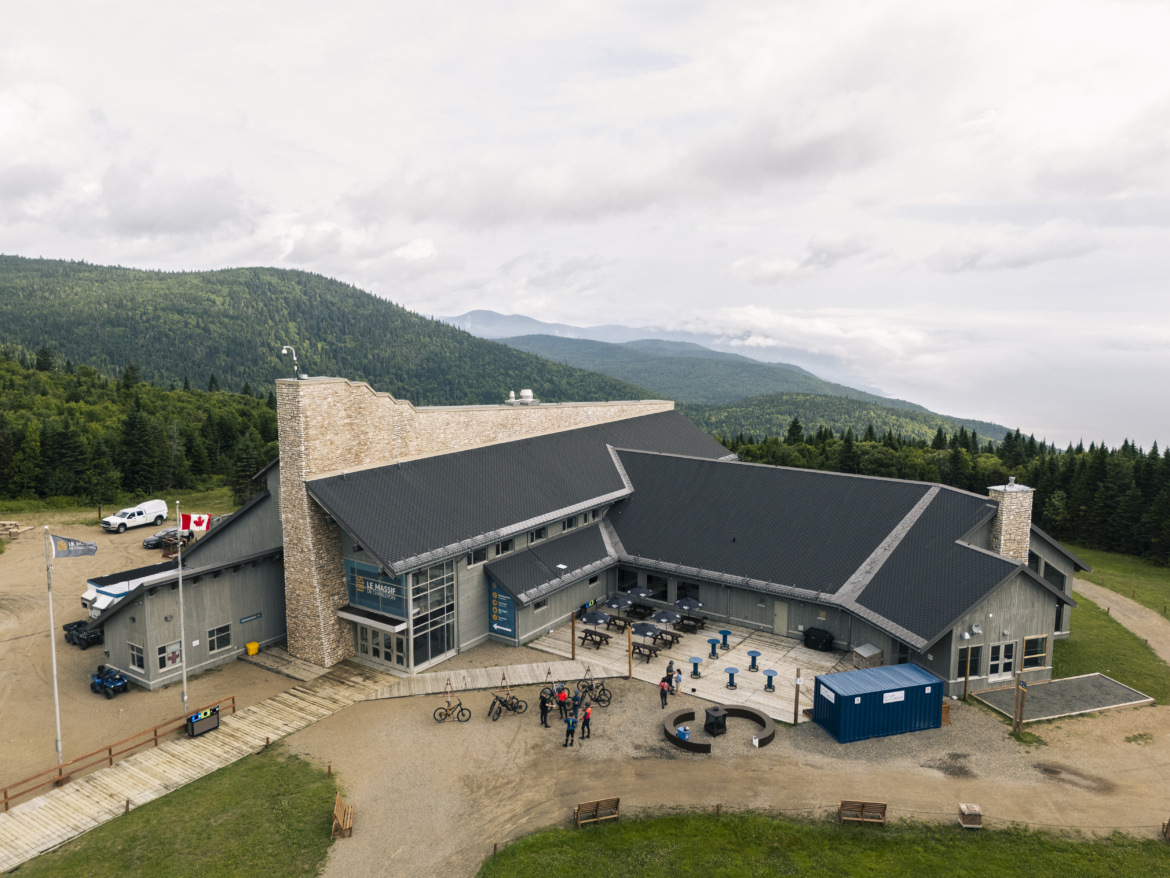
If that’s not your jam, you can stay in one of the more affordable rental options located on the hill. Or if you’d prefer to stay in a bustling downtown area, consider heading further northeast to the town of Baie-Saint-Paul.
Baie-Saint-Paul offers a walkable downtown strip with historic buildings and excellent restaurants. For a great microbrewery, try Le Saint-Pub. Le Mouton Noir and L’Orange Bistro are also highly rated, but many other options exist.
To jump in the water for a refreshing post-ride dip, head just southeast of downtown on Rue Sainte Anne to find a fantastic beach. Really, is there any better way to wrap up a long day (or week) of mountain biking than a cold swim and then stretching out to dry in the hot sun?!
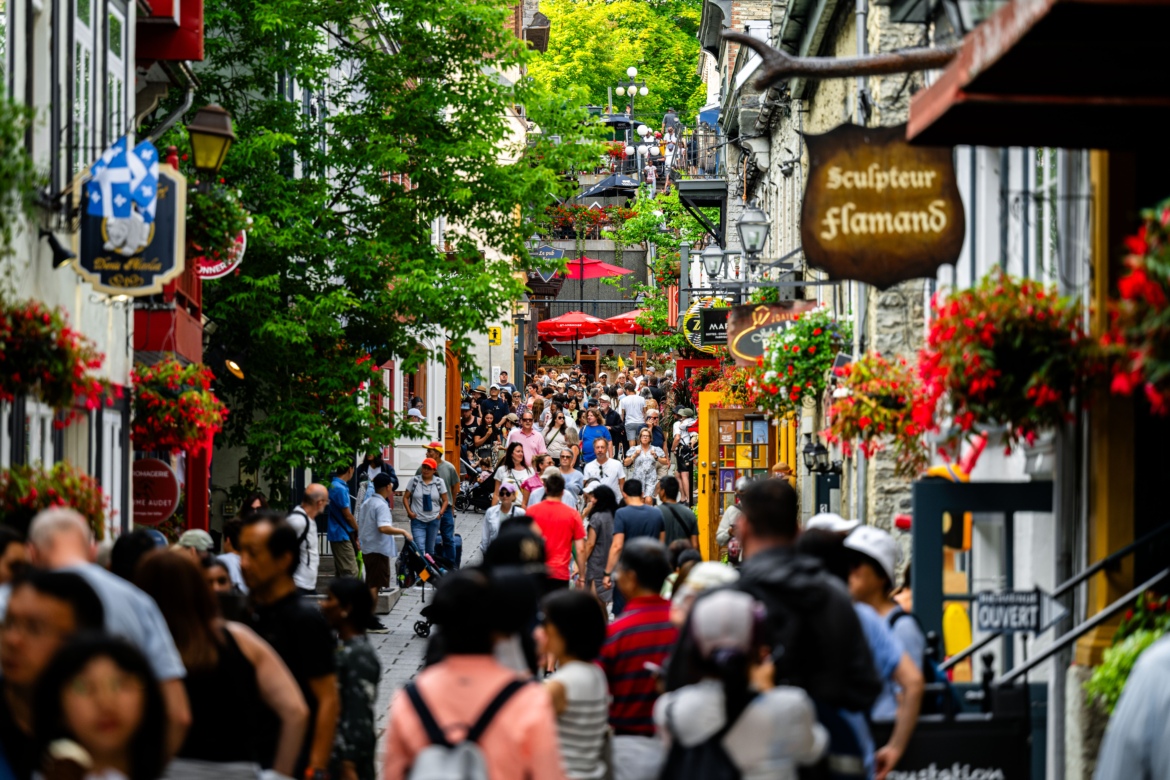
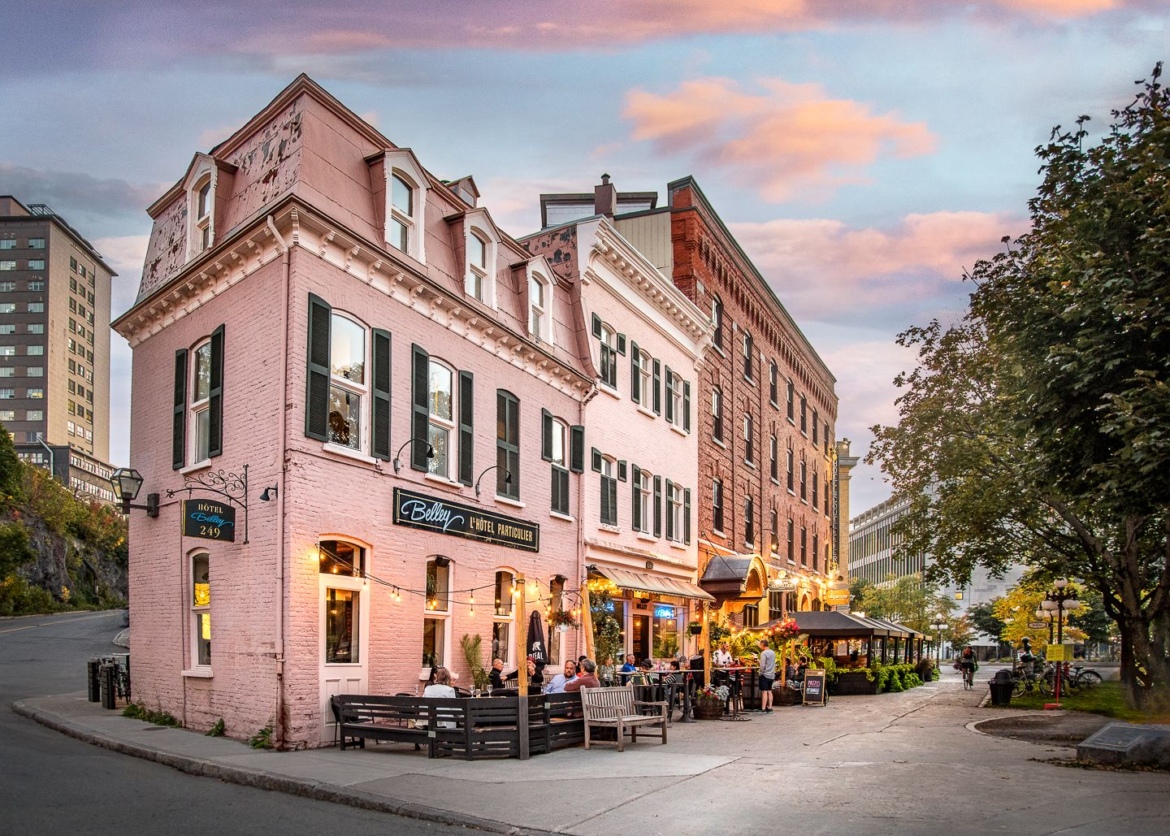
A trip to Quebec City is about more than just riding
The heart of French-speaking Canada is often hailed as the most European city in North America, and as a self-professed Europhile, I’ve long wanted to investigate it for myself. Having just returned from two weeks of bike touring across Europe, I can confirm that Quebec City fits the bill. The old town is ringed by a historic wall fitted with cannons. The houses and public buildings in the city center are crafted from stone blocks and rise high into the sky. The city is filled with incredible architecture, including a cathedral, numerous other churches, plenty of government buildings, and the iconic castle hotel, Fairmont Le Chateau Frontenac.

For those of us who enjoy both the challenge and change of perspective that traveling to non-English-speaking countries can provide, Quebec offers a cultural experience on par with more far-flung destinations. You won’t find these cultural differences when visiting western Canada, where provinces like British Columbia and Alberta feel like a mirror image of my home state of Colorado.
When you travel to Quebec, it truly feels like you’re exploring a distinct and unique place.
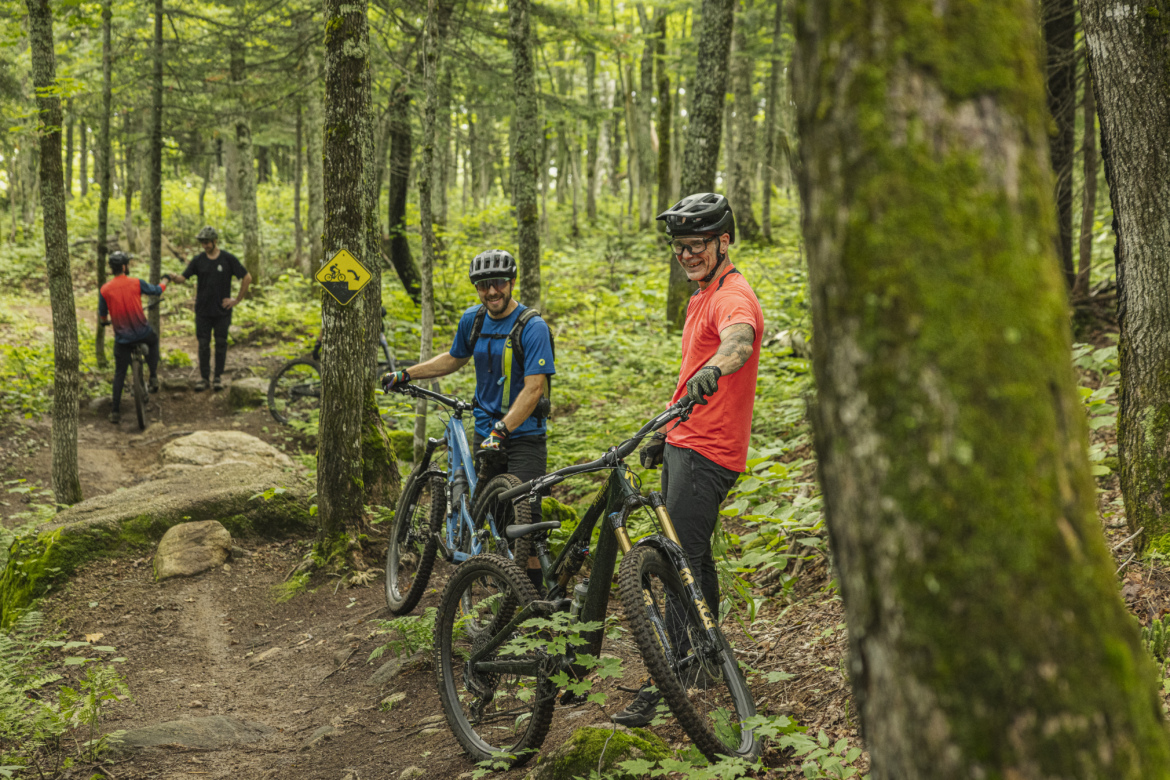
A massive “thank you” to all the local riders who came out to help with these photo shoots!

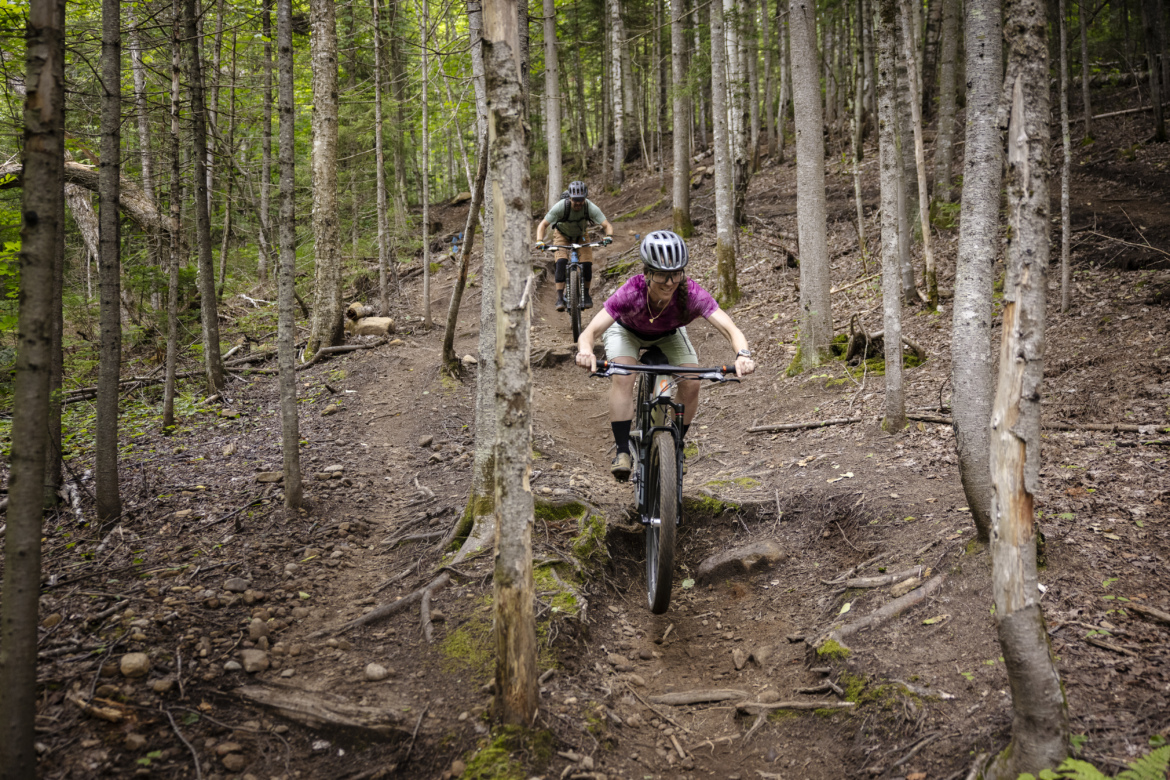
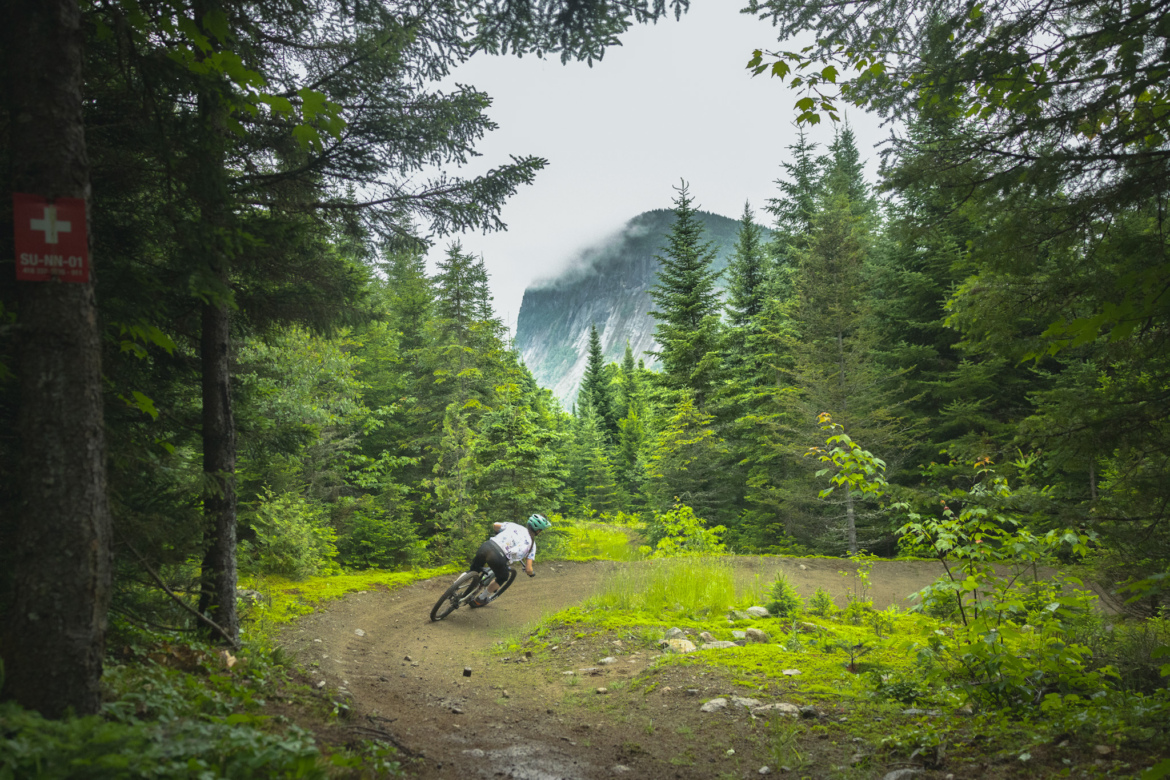
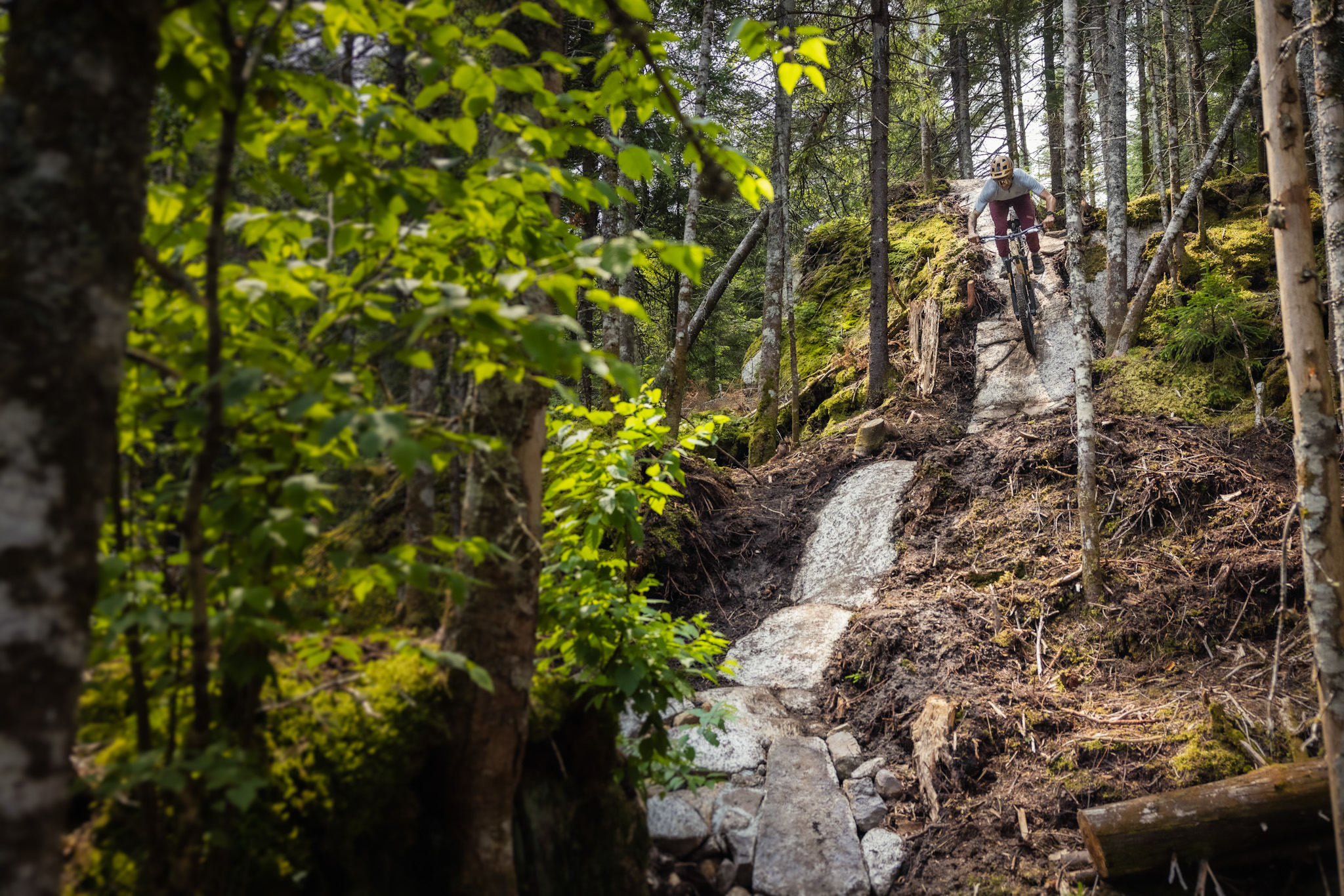

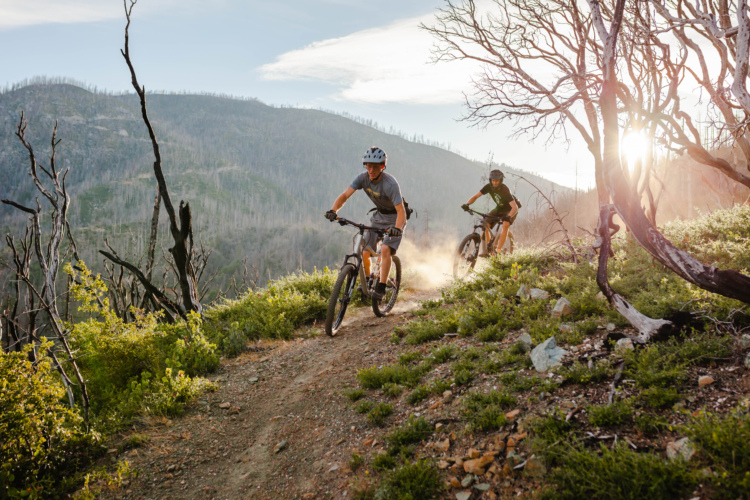
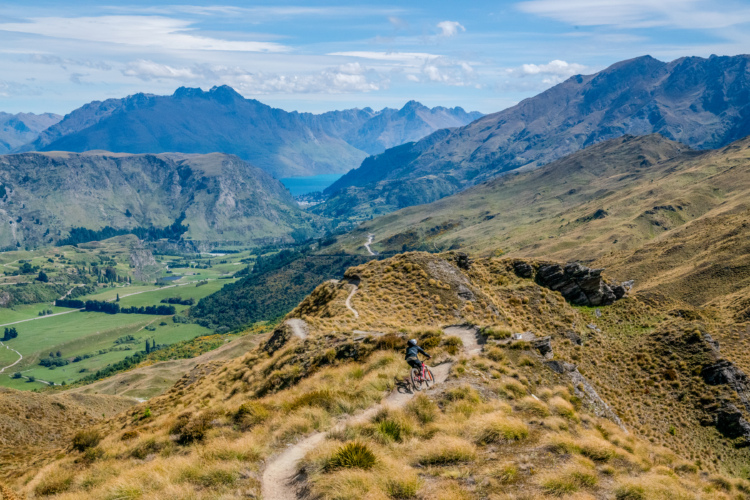

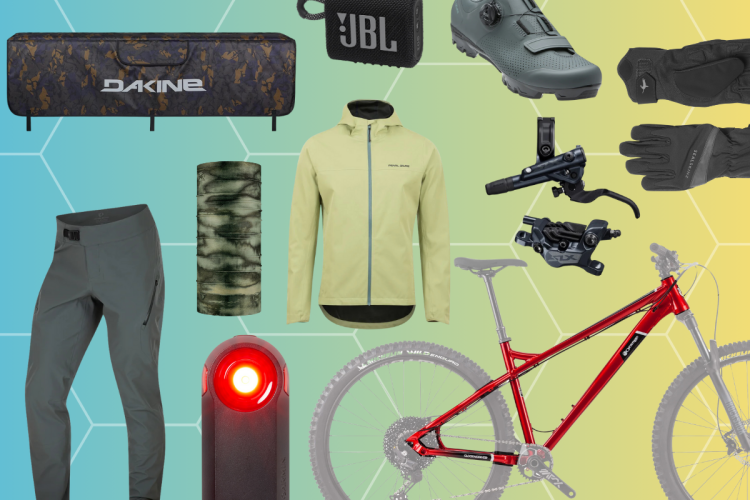
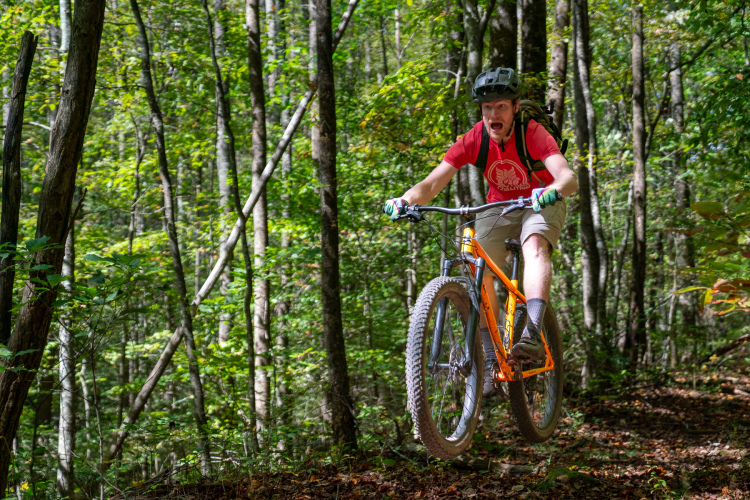
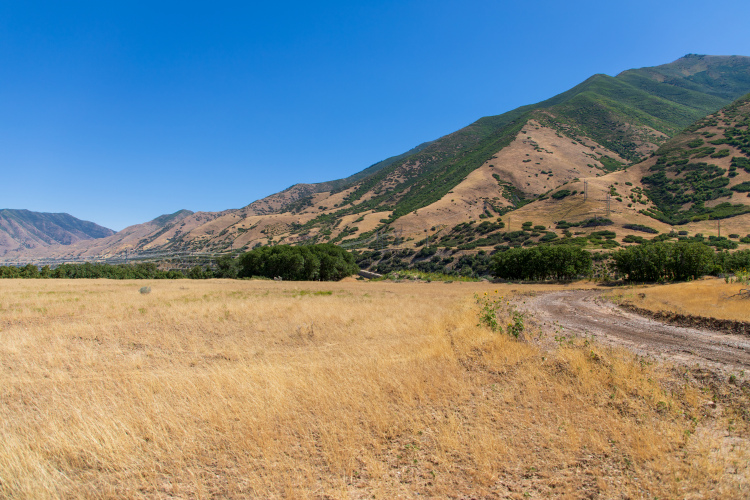


0 Comments